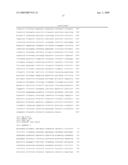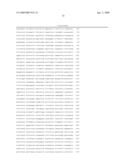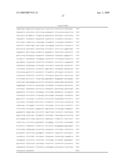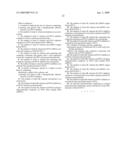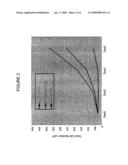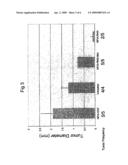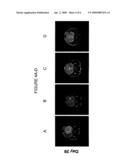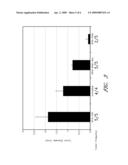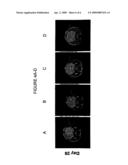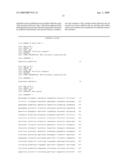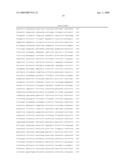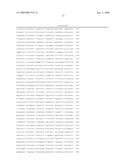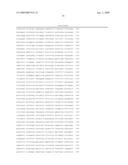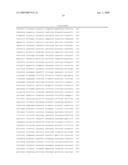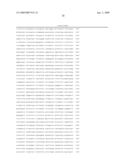Patent application title: NFIA IN GLIAL FATE DETERMINATION, GLIOMA THERAPY AND ASTROCYTOMA TREATMENT
Inventors:
David J. Anderson (Altadena, CA, US)
David J. Anderson (Altadena, CA, US)
Ben Deneen (Alhambra, CA, US)
Hae-Ri Song (Pasadena, CA, US)
IPC8 Class: AA61K39395FI
USPC Class:
4241381
Class name: Drug, bio-affecting and body treating compositions immunoglobulin, antiserum, antibody, or antibody fragment, except conjugate or complex of the same with nonimmunoglobulin material binds expression product or fragment thereof of cancer-related gene (e.g., oncogene, proto-oncogene, etc.)
Publication date: 2009-04-02
Patent application number: 20090087434
Claims:
1. A method of reducing the size of a glioma, comprising,contacting said
glioma with a therapeutically effective amount of an NFIA inhibitor.
2. The method of claim 1, wherein said glioma is an astrocytoma.
3. The method of claim 1, wherein said NFIA inhibitor comprises an NFIA antisense polynucleotide.
4. The method of claim 3, wherein said NFIA inhibitor comprises an NFIA short hairpin RNA (shRNA).
5. The method of claim 4, wherein said shRNA targets human NFIA.
6. The method of claim 5, wherein the NFIA shRNA comprises the sequence of SEQ ID NO: 1.
7. The method of claim 3, wherein said contacting step comprises contacting said glioma with a viral expression vector that comprises said NFIA antisense polynucleotide.
8. The method of claim 1, wherein the contacting step comprises injecting said NFIA inhibitor into said glioma.
9. The method of claim 1, wherein said NFIA inhibitor is an antibody that specifically binds to NFIA.
10. A method of treating a glioma in a subject in need thereof, comprisingidentifying a subject with a glioma; andcontacting said glioma with a therapeutically effective amount of an NFIA inhibitor.
11. The method of claim 10, wherein said glioma is an astrocytoma.
12. The method of claim 10, wherein said NFIA inhibitor is an NFIA antisense polynucleotide.
13. The method of claim 12, wherein said NFIA antisense oligonucleotide comprises an NFIA short hairpin RNA (shRNA).
14. The method of claim 13, wherein the shRNA targets human NFIA.
15. The method of claim 14, wherein said shRNA comprises SEQ ID NO: 1.
16. The method of claim 12, wherein the NFIA inhibitor comprises a viral expression vector that comprises said NFIA antisense polynucleotide.
17. The method of claim 10, wherein the contacting step comprises injecting said NFIA inhibitor into said glioma.
18. The method of claim 10, wherein said NFIA inhibitor is an antibody that specifically binds to NFIA.
19. A method of treating a glioma, comprisingreducing the amount of functional NFIA in the cells comprising said glioma,wherein said reducing step comprises contacting said glioma with an NFIA inhibitor.
20. The method of claim 19, wherein said NFIA inhibitor is an NFIA antisense polynucleotide.
21. The method of claim 20, wherein said NFIA antisense oligonucleotide comprises an NFIA short hairpin RNA (shRNA).
22. The method of claim 21, wherein the shRNA targets human NFIA.
23. The method of claim 22, wherein said shRNA comprises SEQ ID NO: 1.
24. The method of claim 20, wherein the NFIA inhibitor comprises a viral expression vector that comprises said NFIA antisense polynucleotide.
25. The method of claim 10, wherein said NFIA inhibitor is an antibody that specifically binds to NFIA.
26. An antisense polynucleotide comprising an isolated polynucleotide comprising a nucleic acid that is at least 90% identical to SEQ ID NO: 1.
Description:
CROSS-REFERENCE TO RELATED APPLICATIONS
[0001]The present application claims priority to U.S. Provisional Application Ser. No. 60/994,753, filed on Sep. 21, 2007, by Anderson et al. and entitled "NFIA IN GLIAL FATE DETERMINATION, GLIOMA THERAPY AND ASTROCYTOMA TREATMENT WITH RNAi," which is hereby expressly incorporated by reference in its entirety.
PARTIES OF JOINT RESEARCH AGREEMENT
[0003]This invention was made as a result of activities undertaken within the scope of a joint research agreement between the California Institute of Technology and Children's Hospital, Los Angeles.
SEQUENCE LISTING
[0004]The present application is being filed along with a sequence listing in electronic format. The sequence listing is provided as a file entitled CALTE044A.txt, created Sep. 19, 2008, which is 23.0 KB in size. The information in the electronic format of the sequence listing is incorporated herein by reference in its entirety.
FIELD OF THE INVENTION
[0005]Embodiments disclosed herein relate to molecular medicine, and in particular to compositions and methods that can be used for glioma and astrocytoma therapy and treatment.
DESCRIPTION OF THE RELATED ART
[0006]Gliomas, tumors derived from glia cells of the central nervous system (CNS) account for approximately 30% of all primary brain tumors in adults. The median survival rate is about 12 months. Gliomas are usually treated by surgery, chemotherapy, radiotherapy and/or fractionated stereotype radio surgery.
[0007]Gliomas are heterogeneous in their cellular content and can be divided into groups of astrocytomas, anablastic astrocytomas and glioblastoma multiformes. Traditional approaches to therapeutic intervention have relied upon either surgery, chemotherapy, or radiotherapy. Recent advances in molecular genetics have revealed many genetic mutations and associated signaling pathways that may play a causative role in the generation of gliomas. While these advances have provided numerous candidate pathways that can be utilized in the development of rational therapy rooted in the biology of the disease, it remains to be seen whether such approaches will come to fruition. As such, there is a continued need for gliomal therapies.
[0008]The Nuclear Factor I (NFI) family of genes are glial fate determinants in the developing central nervous system. Interestingly, NFIA is also expressed in all grades of human astroctyoma, the most deadly form of glioma. Described herein is Applicants' discovery that NFIA plays a causative role in glioma formation and Applicants' discovery of therapeutics based on the elucidation of NFIA's role in glioma formation.
SUMMARY OF THE INVENTION
[0009]Provided herein are methods and compositions for glioma therapy and treatment. Some embodiments provided herein relate to methods for reducing the size of a glioma. Some embodiments relate to methods of arresting or slowing the development or progression of gliomal tumors. In some embodiments, the gliomas can be astrocytomas.
[0010]In some embodiments, the methods described herein include the steps of contacting a glioma with a therapeutically effective amount of an NFIA inhibitor. In some embodiments, the NFIA inhibitor can include an NFIA antisense polynucleotide, such as an NFIA short hairpin RNA (shRNA). In some embodiments, the shRNA NFIA inhibitor can target human NFIA. For example, in some embodiments, the NFIA inhibitor can be an NFIA shRNA that comprises the sequence of SEQ ID NO: 1. In some embodiments, the contacting step comprises contacting the glioma with a viral expression vector that encodes an NFIA antisense polynucleotide, such as a lentiviral expression vector.
[0011]In some embodiments, the NFIA inhibitor can be an antibody that specifically binds to NFIA.
[0012]Some embodiments provide an NFIA antisense polynucleotide. In some embodiments, the NFIA antisense polynucleotide comprises an isolated polynucleotide comprising the sequence of SEQ ID NO: 1.
BRIEF DESCRIPTION OF THE DRAWINGS
[0013]FIG. 1 is a bar graph showing the relative expression levels of NFIA in U87 glioma cells that were either untreated, treated with a mutant NFIA shRNA, or treated with an NFIA shRNA that targets human NFIA.
[0014]FIG. 2 is a graph showing the growth (as expressed in total cell number) of U87 glioma cells infected with either a viral construct encoding a human NFIA shRNA or a mutant version of the human NFIA shRNA, or that were not infected.
[0015]FIG. 3 is a graph showing the size and frequency of tumors in mice receiving transplants of: U87 glioma cells transduced with a lentiviral expression vector encoding NFIA cDNA; untreated U87 cells, U87 cells transduced with either a lentiviral construct encoding a NFIA shRNA; or U87 cells transduced with a lentiviral construct encoding a mutant version of the NFIA shRNA.
[0016]FIG. 4A-4D are images of MRIs of genetically modified U87 cells implanted into a mouse brain, 28 days post implantation. The arrows denote tumor growth.
DETAILED DESCRIPTION OF THE PREFERRED EMBODIMENT
[0017]The embodiments disclosed herein relate to the treatment of gliomas and are based, in part, on Applicants' discovery that Nuclear Factor IA (NFIA) plays a role in glioma formation.
[0018]Embodiments herein relate to methods for treating gliomas, for reducing the tumor size of gliomas, and for reducing the functional NFIA levels in gliomas with NFIA inhibitors. The term "NFIA inhibitor" refers to a compound or composition that reduces the functional NFIA levels in a target cell (e.g. a glioma cell). NFIA inhibitors can function by inhibiting the expression of NFIA, for example by inhibiting transcription, translation, or processing of NFIA, or by inhibiting a functional activity of NFIA, such as DNA binding. NFIA inhibitors include, but are not limited to, antisense polynucleotides, antibodies, and small molecule inhibitors of NFIA.
NFIA Antisense Polynucleotides
[0019]In some embodiments, an NFIA inhibitor can be an NFIA antisense polynucleotide. Examples of antisense polynucleotides useful in the embodiments disclosed herein include single-stranded DNAs and RNAs that bind to complementary target mRNA and inhibit translation and/or induce RNaseH-mediated degradation of the target transcript; siRNA oligonucleotides, which are short, double-stranded RNAs that activate the RNA interference (RNAi) pathway leading to target mRNA degradation; ribozymes, which are oligonucleotide-based endonucleases that are designed to cleave specific mRNA transcripts; and nucleic acid aptamers and decoys, which are non-naturally occurring oligonucleotides that bind to and block protein targets in a manner analogous to small molecule drugs.
[0020]As used herein, the term "oligonucleotide" refers to an oligomer or polymer of nucleic acids such as ribonucleic acid (RNA) or deoxyribonucleic acid (DNA) or mimetics thereof. This term includes oligonucleotides composed of naturally-occurring nucleobases, sugars and covalent internucleoside (backbone) linkages as well as oligonucleotides having non-naturally-occurring portions which function similarly. Modified or substituted oligonucleotides provide desirable properties such as, for example, enhanced cellular uptake, enhanced affinity for nucleic acid target and increased stability in the presence of nucleases.
[0021]In addition to antisense oligonucleotides that comprise only naturally occurring nucleobases, in some embodiments, the antisense oligonucleotides provided herein can be oligomeric oligonucleotide mimetics. Accordingly, in some embodiments, antisense compounds provided herein include oligonucleotides containing modified backbones or non-natural internucleoside linkages. Oligonucleotides having modified backbones include those that retain a phosphorus atom in the backbone and those that do not have a phosphorus atom in the backbone.
[0022]In some embodiments, the antisense polynucleotides comprise oligomeric oligonucleotide backbones include, for example, phosphorothioates, chiral phosphorothioates, phosphorodithioates, phosphotriesters, aminoalkylphosphotri-esters, methyl and other alkyl phosphonates including 3'-alkylene phosphonates, 5'-alkylene phosphonates and chiral phosphonates, phosphinates, phosphoramidates including 3'-amino phosphoramidate and aminoalkylphosphoramidates, thionophosphoramidates, thionoalkylphosphonates, thionoalkylphosphotriesters, selenophosphates and borano-phosphates having normal 3'-5' linkages, 2'-5' linked analogs of these, and those having inverted polarity wherein one or more internucleotide linkages is a 3' to 3', 5' to 5' or 21 to 2' linkage. Oligonucleotides having inverted polarity can comprise a single 3' to 3' linkage at the 3'-most internucleotide linkage i.e. a single inverted nucleoside residue which may be abasic (the nucleobase is missing or has a hydroxyl group in place thereof). Various salts, mixed salts and free acid forms are also included.
[0023]Representative United States patents that teach the preparation of the above phosphorus-containing linkages include, but are not limited to, U.S. Pat. Nos. 3,687,808; 4,469,863; 4,476,301; 5,023,243; 5,177,196; 5,188,897; 5,264,423; 5,276,019; 5,278,302; 5,286,717; 5,321,131; 5,399,676; 5,405,939; 5,453,496; 5,455,233; 5,466,677; 5,476,925; 5,519,126; 5,536,821; 5,541,306; 5,550,111; 5,563,253; 5,571,799; 5,587,361; 5,194,599; 5,565,555; 5,527,899; 5,721,218; 5,672,697 and 5,625,050, each of which is herein incorporated by reference in its entirety.
[0024]In some embodiments, NFIA antisense polynucleotides can comprise modified oligonucleotide backbones that do not include a phosphorus atom. NFIA antisense polynucleotides can have backbones formed by short chain alkyl or cycloalkyl internucleoside linkages, mixed heteroatom and alkyl or cycloalkyl internucleoside linkages, or one or more short chain heteroatomic or heterocyclic internucleoside linkages. These include those having morpholino linkages (formed in part from the sugar portion of a nucleoside); siloxane backbones; sulfide, sulfoxide and sulfone backbones; formacetyl and thioformacetyl backbones; methylene formacetyl and thioformacetyl backbones; riboacetyl backbones; alkene containing backbones; sulfamate backbones; methyleneimino and methylenehydrazino backbones; sulfonate and sulfonamide backbones; amide backbones; and others having mixed N, O, S and CH2 component parts.
[0025]Representative United States patents that teach the preparation of the above oligonucleosides include, but are not limited to, U.S. Pat. Nos. 5,034,506; 5,166,315; 5,185,444; 5,214,134; 5,216,141; 5,235,033; 5,264,562; 5,264,564; 5,405,938; 5,434,257; 5,466,677; 5,470,967; 5,489,677; 5,541,307; 5,561,225; 5,596,086; 5,602,240; 5,610,289; 5,602,240; 5,608,046; 5,610,289; 5,618,704; 5,623,070; 5,663,312; 5,633,360; 5,677,437; 5,792,608; 5,646,269 and 5,677,439, certain of which are commonly owned with this application, and each of which is herein incorporated by reference.
[0026]In some embodiments, NFIA antisense polynucleotides can comprise mimetics wherein both the sugar and the internucleoside linkage, i.e., the backbone, of the nucleotide units are replaced with non-naturally occurring groups. In some embodiments, the base units are maintained for hybridization with an appropriate target polynucleotides. For example, some embodiments provide NFIA antisense polynucleotides that comprise a peptide nucleic acid (PNA). In PNA compounds, the sugar-backbone of an oligonucleotide is replaced with an amide containing backbone, in particular an aminoethylglycine backbone. The nucleobases are retained and are bound directly or indirectly to aza nitrogen atoms of the amide portion of the backbone. Representative United States patents that teach the preparation of PNA compounds include, but are not limited to, U.S. Pat. Nos. 5,539,082; 5,714,331; and 5,719,262, each of which is herein incorporated by reference in its entirety. Further teaching of PNA compounds can be found in Nielsen et al., Science, 1991, 254, 1497-1500.
[0027]In some embodiments, NFIA antisense oligonucleotides can have phosphorothioate backbones and oligonucleosides with heteroatom backbones, and in particular --CH2--NH--O--CH2--, --CH2--N(CH3)--O--CH2--[known as a methylene (methylimino) or MMI backbone], --CH2--O--N(CH3)--CH2--, --CH2--N(CH3)--N(CH3)--CH2-- and --O--N(CH3)--CH2--CH2--[wherein the native phosphodiester backbone is represented as --O--P--O--CH2--] of the above referenced U.S. Pat. No. 5,489,677, and the amide backbones of the above referenced U.S. Pat. No. 5,602,240. Other mimetics that are present in some embodiments of the antisense polynucleotides disclosed herein include morpholino backbone structures described in U.S. Pat. No. 5,034,506, herein incorporated by reference in its entirety.
[0028]In some embodiments, the NFIA antisense polynucleotides can contain one or more substituted sugar moieties. In some embodiments, the antisense oligonucleotides disclosed herein comprise one of the following at the 2' position: OH; F; O-, S-, or N-alkyl; O-, S-, or N-alkenyl; O-, S- or N-alkynyl; or O-alkyl-O-alkyl, wherein the alkyl, alkenyl and alkynyl may be substituted or unsubstituted C1 to C10 alkyl or C2 to C10 alkenyl and alkynyl. In some embodiments, the antisense oligonucleotides can include one of the following groups at the 2' position: O[(CH2)nO]mCH3, O(CH2)nOCH3, O(CH2)nNH2, O(CH2)nCH3, O(CH2)nONH2, and O(CH2)nON[(CH2)nCH3)]2, where n and m are from 1 to about 10. In some embodiments, the antisense oligonucleotides comprise one of the following at the 2' position: C1 to C10 lower alkyl, substituted lower alkyl, alkenyl, alkynyl, alkaryl, aralkyl, O-alkaryl or O-aralkyl, SH, SCH3, OCN, Cl, Br, CN, CF3, OCF3, SOCH3, SO2CH3, ONO2, NO2, N3, NH2, heterocycloalkyl, heterocycloalkaryl, aminoalkylamino, polyalkylamino, substituted silyl, an RNA cleaving group, a reporter group, an intercalator, a group for improving the pharmacokinetic properties of an oligonucleotide, or a group for improving the pharmacodynamic properties of an oligonucleotide, and other substituents having similar properties. In some embodiments, the antisense oligonucleotides include 2'-methoxyethoxy (2'-O--CH2CH2OCH3, also known as 2'-O-(2-methoxyethyl) or 2'-MOE) (Martin et al., Helv. Chim. Acta, 1995, 78, 486-504) i.e., an alkoxyalkoxy group. In some embodiments, the antisense polynucleotides or oligonucleotides disclosed herein include 2'-dimethylaminooxyethoxy, i.e., a O(CH2)2ON(CH3)2 group, also known as 2'-DMAOE, and 2'-dimethylaminoethoxyethoxy (also known in the art as 2'-O-dimethylaminoethoxyethyl or 2'-DMAEOE), i.e., 2'-O--CH2--O--CH2--N(CH2)2, also described in examples herein below.
[0029]In some embodiments, the NFIA antisense polynucleotides and oligonucleotides can include Locked Nucleic Acids (LNAs) in which the 2'-hydroxyl group is linked to the 3' or 4' carbon atom of the sugar ring thereby forming a bicyclic sugar moiety. The linkage can be a methelyne (--CH2--)n group bridging the 2' oxygen atom and the 4' carbon atom wherein n is 1 or 2. LNAs and preparation thereof are described in WO 98/39352 and WO 99/14226, each of which is herein incorporated by reference in its entirety.
[0030]In some embodiments, the NFIA antisense polynucleotides and oligonucleotides can include 2'-methoxy (2'-O--CH3), 2'-aminopropoxy (2'-OCH2CH2CH2NH2), 2'-allyl (2'-CH2--CH═CH2), 2'-O-allyl (2'-O--CH2--CH═CH2--) and 2'-fluoro (2'-F). The 2'-modification may be in the arabino (up) position or ribo (down) position. In some embodiments, the 2'-arabino modification is 2'-F. Similar modifications may also be made at other positions on the oligonucleotide, particularly the 3' position of the sugar on the 3' terminal nucleotide or in 2'-5 linked oligonucleotides and the 5' position of 5' terminal nucleotide. Oligonucleotides may also have sugar mimetics such as cyclobutyl moieties in place of the pentofuranosyl sugar. Representative United States patents that teach the preparation of such modified sugar structures include, but are not limited to, U.S. Pat. Nos. 4,981,957; 5,118,800; 5,319,080; 5,359,044; 5,393,878; 5,446,137; 5,466,786; 5,514,785; 5,519,134; 5,567,811; 5,576,427; 5,591,722; 5,597,909; 5,610,300; 5,627,053; 5,639,873; 5,646,265; 5,658,873; 5,670,633; 5,792,747; and 5,700,920, certain of which are commonly owned with the instant application, and each of which is herein incorporated by reference in its entirety.
[0031]Oligonucleotides may also include nucleobase (often referred to in the art simply as "base") modifications or substitutions. As used herein, "unmodified" or "natural" nucleobases include the purine bases adenine (A) and guanine (G), and the pyrimidine bases thymine (T), cytosine (C) and uracil (U). Modified nucleobases include other synthetic and natural nucleobases such as 5-methylcytosine (5-me-C), 5-hydroxymethyl cytosine, xanthine, hypoxanthine, 2-aminoadenine, 6-methyl and other alkyl derivatives of adenine and guanine, 2-propyl and other alkyl derivatives of adenine and guanine, 2-thiouracil, 2-thiothymine and 2-thiocytosine, 5-halouracil and cytosine, 5-propynyl uracil and cytosine and other alkynyl derivatives of pyrimidine bases, 6-azo uracil, cytosine and thymine, 5-uracil (pseudouracil), 4-thiouracil, 8-halo, 8-amino, 8-thiol, 8-thioalkyl, 8-hydroxyl and other 8-substituted adenines and guanines, 5-halo particularly 5-bromo, 5-trifluoromethyl and other 5-substituted uracils and cytosines, 7-methylguanine and 7-methyladenine, 2-F-adenine, 2-amino-adenine, 8-azaguanine and 8-azaadenine, 7-deazaguanine and 7-deazaadenine and 3-deazaguanine and 3-deazaadenine. Further modified nucleobases include tricyclic pyrimidines such as phenoxazine cytidine(1H-pyrimido[5,4-b][1,4]benzoxazin-2(3H)-one), phenothiazine cytidine (1H-pyrimido[5,4-b][1,4]benzothiazin-2(3H)-one), G-clamps such as a substituted phenoxazine cytidine (e.g. 9-(2-aminoethoxy)-H-pyrimido[5,4-b][1,4]benzoxazin-2(3H)-one), carbazole cytidine (2H-pyrimido[4,5-b]indol-2-one), pyridoindole cytidine (H-pyrido[3',2':4,5]pyrrolo[2,3-d]pyrimidin-2-one). Modified nucleobases may also include those in which the purine or pyrimidine base is replaced with other heterocycles, for example 7-deaza-adenine, 7-deazaguanosine, 2-aminopyridine and 2-pyridone. Further nucleobases include those disclosed in U.S. Pat. No. 3,687,808, those disclosed in The Concise Encyclopedia Of Polymer Science And Engineering, pages 858-859, Kroschwitz, J. I., ed. John Wiley & Sons, 1990, those disclosed by Englisch et al., Angewandte Chemie, International Edition, 1991, 30, 613, and those disclosed by Sanghvi, Y. S., Chapter 15, Antisense Research and Applications, pages 289-302, Crooke, S. T. and Lebleu, B. ed., CRC Press, 1993. Certain of these nucleobases are particularly useful for increasing the binding affinity of the oligomeric compounds of the invention. These include 5-substituted pyrimidines, 6-azapyrimidines and N-2, N-6 and O-6 substituted purines, including 2-aminopropyladenine, 5-propynyluracil and 5-propynylcytosine. 5-methylcytosine substitutions have been shown to increase nucleic acid duplex stability by 0.6-1.2° C. (Sanghvi, Y. S., Crooke, S. T. and Lebleu, B., eds., Antisense Research and Applications, CRC Press, Boca Raton, 1993, pp. 276-278) and are presently preferred base substitutions, even more particularly when combined with 2'-O-methoxyethyl sugar modifications.
[0032]Representative United States patents that teach the preparation of certain of the above noted modified nucleobases as well as other modified nucleobases include, but are not limited to, the above noted U.S. Pat. No. 3,687,808, as well as U.S. Pat. Nos. 4,845,205; 5,130,302; 5,134,066; 5,175,273; 5,367,066; 5,432,272; 5,457,187; 5,459,255; 5,484,908; 5,502,177; 5,525,711; 5,552,540; 5,587,469; 5,594,121, 5,596,091; 5,614,617; 5,645,985; 5,830,653; 5,763,588; 6,005,096; and 5,681,941, each of which is herein incorporated by reference, and U.S. Pat. No. 5,750,692, which is commonly owned with the instant application and also herein incorporated by reference.
[0033]In some embodiments, the NFIA antisense oligonucleotides can be chemically linked to one or more moieties or conjugates which enhance the activity, cellular distribution or cellular uptake of the oligonucleotide. For example, in some embodiments, the NFIA antisense oligonucleotides can include conjugate groups covalently bound to functional groups such as primary or secondary hydroxyl groups. Exemplary conjugate groups include intercalators, reporter molecules, polyamines, polyamides, polyethylene glycols, polyethers, groups that enhance the pharmacodynamic properties of oligomers, and groups that enhance the pharmacokinetic properties of oligomers, and groups that reduce the anionic charge of the polynucleotides, thereby enhancing transport across cellular membranes. Conjugate groups include cholesterols, lipids, phospholipids, biotin, phenazine, folate, phenanthridine, anthraquinone, acridine, fluoresceins, rhodamines, coumarins, and dyes. Groups that enhance the pharmacodynamic properties, in the context of the NFIA antisense oligonucleotides disclosed herein, include groups that improve oligomer uptake, enhance oligomer resistance to degradation, and/or strengthen sequence-specific hybridization with RNA. Groups that enhance the pharmacokinetic properties, in the context of this invention, include groups that improve oligomer uptake, distribution, metabolism or excretion. Representative conjugate groups are disclosed for example in International Patent Application PCT/US92/09196, filed Oct. 23, 1992, and PCT/US2007/003641, filed Feb. 9, 2007, the entire disclosures of which are incorporated herein by reference in their entireties.
[0034]Other exemplary conjugate moieties useful in the embodiments disclosed herein include but are not limited to lipid moieties such as a cholesterol moiety (Letsinger et al., Proc. Natl. Acad. Sci. USA, 1989, 86, 6553-6556), cholic acid (Manoharan et al., Bioorg. Med. Chem. Let., 1994, 4, 1053-1060), a thioether, e.g., hexyl-5-tritylthiol (Manoharan et al., Ann. N.Y. Acad. Sci., 1992, 660, 306-309; Manoharan et al., Bioorg. Med. Chem. Let., 1993, 3, 2765-2770), a thiocholesterol (Oberhauser et al., Nucl. Acids Res., 1992, 20, 533-538), an aliphatic chain, e.g., dodecandiol or undecyl residues (Saison-Behmoaras et al., EMBO J., 1991, 10, 1111-1118; Kabanov et al., FEBS Lett., 1990, 259, 327-330; Svinarchuk et al., Biochimie, 1993, 75, 49-54), a phospholipid, e.g., di-hexadecyl-rac-glycerol or triethyl-ammonium 1,2-di-O-hexadecyl-rac-glycero-3-H-phosphonate (Manoharan et al., Tetrahedron Lett., 1995, 36, 3651-3654; Shea et al., Nucl. Acids Res., 1990, 18, 3777-3783), a polyamine or a polyethylene glycol chain (Manoharan et al., Nucleosides & Nucleotides, 1995, 14, 969-973), or adamantane acetic acid (Manoharan et al., Tetrahedron Lett., 1995, 36, 3651-3654), a palmityl moiety (Mishra et al., Biochim. Biophys. Acta, 1995, 1264, 229-237), or an octadecylamine or hexylamino-carbonyl-oxycholesterol moiety (Crooke et al., J. Pharmacol. Exp. Ther., 1996, 277, 923-937. Oligonucleotides of the invention may also be conjugated to active drug substances, for example, aspirin, warfarin, phenylbutazone, ibuprofen, suprofen, fenbufen, ketoprofen, (S)-(+)-pranoprofen, carprofen, dansylsarcosine, 2,3,5-triiodobenzoic acid, flufenamic acid, folinic acid, a benzothiadiazide, chlorothiazide, a diazepine, indomethicin, a barbiturate, a cephalosporin, a sulfa drug, an antidiabetic, an antibacterial or an antibiotic, for example. Oligonucleotide-drug conjugates and their preparation are described for example in U.S. patent application Ser. No. 09/334,130 (filed Jun. 15, 1999) which is incorporated herein by reference in its entirety.
[0035]Representative United States patents that teach the preparation of such oligonucleotide conjugates include, but are not limited to, U.S. Pat. Nos. 4,828,979; 4,948,882; 5,218,105; 5,525,465; 5,541,313; 5,545,730; 5,552,538; 5,578,717, 5,580,731; 5,580,731; 5,591,584; 5,109,124; 5,118,802; 5,138,045; 5,414,077; 5,486,603; 5,512,439; 5,578,718; 5,608,046; 4,587,044; 4,605,735; 4,667,025; 4,762,779; 4,789,737; 4,824,941; 4,835,263; 4,876,335; 4,904,582; 4,958,013; 5,082,830; 5,112,963; 5,214,136; 5,082,830; 5,112,963; 5,214,136; 5,245,022; 5,254,469; 5,258,506; 5,262,536; 5,272,250; 5,292,873; 5,317,098; 5,371,241, 5,391,723; 5,416,203, 5,451,463; 5,510,475; 5,512,667; 5,514,785; 5,565,552; 5,567,810; 5,574,142; 5,585,481; 5,587,371; 5,595,726; 5,597,696; 5,599,923; 5,599,928 and 5,688,941, certain of which are commonly owned with the instant application, and each of which is herein incorporated by reference.
[0036]In some embodiments, some or all positions in an NFIA antisense oligonucleotide or polynucleotide can be modified. In other embodiments, the NFIA antisense oligonucleotides do not contain any modified units. In still other embodiments, the NFIA antisense oligonucleotides disclosed herein are not uniformly modified. In some embodiments, more than one of the aforementioned modifications can be incorporated in a single NFIA antisense polynucleotide or oligonucleotide, or even at a single nucleoside within an oligonucleotide.
[0037]In some embodiments, the antisense compounds are chimeric. As used herein, the term "chimeric" antisense compounds or "chimeras," refer to antisense compounds, particularly oligonucleotides, which contain two or more chemically distinct regions, each made up of at least one monomer unit, i.e., a nucleotide in the case of an oligonucleotide compound. These oligonucleotides typically contain at least one region wherein the oligonucleotide is modified so as to confer upon the oligonucleotide increased resistance to nuclease degradation, increased cellular uptake, and/or increased binding affinity for the target nucleic acid. An additional region of the oligonucleotide may serve as a substrate for enzymes capable of cleaving RNA:DNA or RNA:RNA hybrids. By way of example, RNase H is a cellular endonuclease which cleaves the RNA strand of an RNA:DNA duplex. Activation of RNase H, therefore, results in cleavage of the RNA target, thereby greatly enhancing the efficiency of oligonucleotide inhibition of gene expression. Consequently, comparable results can often be obtained with shorter oligonucleotides when chimeric oligonucleotides are used, compared to phosphorothioate deoxyoligonucleotides hybridizing to the same target region. Cleavage of the RNA target can be routinely detected by gel electrophoresis and, if necessary, associated nucleic acid hybridization techniques known in the art.
[0038]In some embodiments, chimeric NFIA antisense compounds can be formed as composite structures of two or more oligonucleotides, modified oligonucleotides, oligonucleosides and/or oligonucleotide mimetics as described above. Such compounds have also been referred to in the art as hybrids or gapmers. Representative United States patents that teach the preparation of such hybrid structures include, but are not limited to, U.S. Pat. Nos. 5,013,830; 5,149,797; 5,220,007; 5,256,775; 5,366,878; 5,403,711; 5,491,133; 5,565,350; 5,623,065; 5,652,355; 5,652,356; and 5,700,922, each of which is herein incorporated by reference in its entirety.
[0039]NFIA antisense compounds disclosed herein can be conveniently and routinely made through the well-known technique of solid phase synthesis. Equipment for such synthesis is sold by several vendors including, for example, Applied Biosystems (Foster City, Calif.), BioAutomation (Irving, Tex.), or the like. Any other means for such synthesis known in the art may additionally or alternatively be employed. It is well known to use similar techniques to prepare oligonucleotides such as the phosphorothioates and alkylated derivatives.
[0040]NFIA antisense polynucleotides and oligonucleotides provided herein include any pharmaceutically acceptable salts, esters, or salts of such esters, or any other compound which, upon administration to an animal including a human, is capable of providing (directly or indirectly) the biologically active metabolite or residue thereof. Accordingly, for example, NFIA antisense polynucleotides and oligonucleotides can include prodrugs and pharmaceutically acceptable salts of the antisense polynucleotides, pharmaceutically acceptable salts of such prodrugs, and other bioequivalents.
[0041]As used herein, the term "prodrug" indicates a therapeutic agent that is prepared in an inactive form that is converted to an active form within the body or cells thereof by the action of endogenous enzymes or other chemicals and/or conditions. By way of example only, some embodiments provide prodrug versions of the NFIA antisense polynucleotides and oligonucleotides prepared as SATE [(S-acetyl-2-thioethyl) phosphate] derivatives according to the methods disclosed in WO 93/24510 to Gosselin et al., published Dec. 9, 1993 or in WO 94/26764 and U.S. Pat. No. 5,770,713 to Imbach et al.
[0042]In some embodiments, the NFIA antisense polynucleotides can be 5-10-mers, 10-15-mers, 15-20 mers, 20-25 mers, 25-30-mers, 30-40-mers, 40-45-mers, 45-50-mers, 50-55-mers, 55-60-mers, 60-65-mers, 65-70-mers, 70-75-mers, 75-80-mers, 80-85-mers, 85-90-mers, 90-95-mers, 95-100-mers, 100-120-mers, 120-140-mers, 140-160-mers, 160-180-mers, 180-200-mers, or greater, or any number in between, including full length genes or RNA transcripts thereof. In some embodiments the NFIA antisense polynucleotide can be, for example, a 43-55-mer that forms a hairpin, wherein about 4-5 of the nucleotide/modified subunits form the turn.
[0043]In some embodiments, NFIA antisense polynucleotides target human NFIA. Several sequences of human NFIA are publicly available, and can be found, for example, under GENBANK® accession numbers NM 005595 (SEQ ID NO: 3); NM 001134673 (SEQ ID NO: 4). In some embodiments, NFIA antisense polynucleotides target NFIA from a different organism, such as a different mammal, such of mice, rats, rabbits, guinea pigs, dogs, cats, sheep, goats, cows, primates, such as monkeys, chimpanzees, and apes, and the like. The skilled artisan will readily appreciate, however, that antisense NFIA polynucleotides can be designed to target any NFIA sequence now known or discovered in the future
[0044]Accordingly, some embodiments provide NFIA antisense polynucleotides that comprise NFIA shRNA sequences. Exemplary NFIA shRNA antisense polynucleotides include, but are not limited to, polynucleotides that comprise, consist essentially of, or consist of at least about 20 consecutive nucleic acids of the nucleic acid sequence of SEQ ID NO: 1, or mimetics thereof. In some embodiments, the NFIA shRNA can have at least 80%, 81%, 82%, 83%, 84%, 85%, 86%, 87%, 88%, 89%, 90%, 91%, 91%, 92%, 93%, 94%, 95%, 96%, 97%, 98%, 99%, or more sequence identity to at least 20 nucleotides of the nucleic acid sequence of SEQ ID NO: 1. Sequence identity can be determined using mathematical algorithms known to those skilled in the art. A non-limiting example of a mathematical algorithm utilized for comparison of sequences is the algorithm of Karlin S and Altschul S F, Proc. Natl. Acad. Sci. USA 87:2264-68 (1990), modified as in Karlin S and Altschul S F, Proc. Natl. Acad. Sci. USA 90:5873-77 (1993). Such an algorithm is incorporated into the NBLAST and XBLAST programs (version 2.0) of Altschul S F et al., J. Mol. Biol. 215:403-10 (1990). BLAST nucleotide searches can be performed with the NBLAST program score=100, wordlength=12 to obtain homologous nucleotide sequences. Another non-limiting algorithm useful for the comparison of sequences is the algorithm of Myers E W and Miller W, Comput. Appl. Biosci. 4:11-17 (1988). Such an algorithm is incorporated into the ALIGN program (version 2.0) which is part of the GCG sequence alignment software package. Another example of a mathematical algorithm utilized for the alignment of nucleic acid sequences is the Wilbur-Lipman algorithm (Wilbur W J and Lipman D J, Proc. Natl. Acad. Sci. USA 80:726-30 (1983)). When using the Wilbur-Lipman algorithm, a window of 20, gap penalty of 3, Ktuple of 3 can be used. Both The Wilbur-Lipman algorithm is incorporated, for example, into the MEGALIGN program (e.g., version 3.1.7) which is part of the DNASTAR sequence analysis software package.
[0045]Additional algorithms for sequence analysis are known in the art, and include ADVANCE and ADAM, described in Torelli A and Robotti C A, Comput. Appl. Biosci. 10:3-5 (1994); and FASTA, described in Pearson W R and Lipman D J, Proc. Natl. Acad. Sci. USA 85:2444-48 (1988).
[0046]In addition to the sequences set forth above, the skilled artisan will appreciate that various other regions of the NFIA coding sequence can be used as siRNA antisense targets, and are useful in the methods described herein. Antisense targets are generally 15-25 bases long, and refer to the region of an mRNA to which an antisense compound hybridizes. Determination of regions of the NFIA coding sequence useful as NFIA inhibitors is NFIA siRNA antisense targets can be selected using routine methods known to those skilled in the art. For example, siRNA targets are routinely identified by scanning an mRNA sequence for AA dinucleotides and recording the 19 nucleotides immediately downstream of the AA. Other methods can also been used to select the siRNA targets. In one example, the selection of the siRNA target sequence is purely empirically determined (see, e.g., Sui G et al., Proc. Natl. Acad. Sci. USA 99:5515-20 (2002)), as long as the target sequence starts with GG and does not share significant sequence homology with other genes as analyzed by BLAST search. In another example, a more elaborate method is employed to select the siRNA target sequences. This procedure exploits an observation that any accessible site in endogenous mRNA can be targeted for degradation by synthetic oligodeoxyribonucleotide/RNase H method (see, e.g., Lee N S et al., Nature Biotechnol. 20:500-05 (2002)).
[0047]In another embodiment, an NFIA antisense hairpin siRNA expression cassette is constructed to contain the sequence corresponding to the target, followed by a short spacer, the antisense strand of the target, and 5-6 Ts as transcription terminator. The order of the sense and antisense strands within the siRNA expression constructs can be altered without affecting the gene silencing activities of the hairpin siRNA. In certain instances, the reversal of the order may cause partial reduction in gene silencing activities.
[0048]In some embodiments, the length of nucleotide sequences that serve as each side of the stem of the hairpin siRNA expression cassette can range, for instance, from 19 to 29 or more. In some embodiments, the loop size can range from 3 to 23 nucleotides. The skilled artisan will appreciate that other lengths and/or loop sizes suitable for siRNAs can also be used. For example, in some embodiments, the stem of the hairpin can be greater than 29 bases long, e.g. 30-50, bases, or more. In some embodiments, the stem of the hairpin can be less than 29 bases, e.g. 5-28 bases. In some embodiments, the loop can be greater than 23 bases long, e.g. 24-50 bases.
[0049]In yet another embodiment, a 5' overhang in the hairpin siRNA construct can be used, provided that the hairpin siRNA provides the described therapeutic benefit, or reduces the levels of functional NFIA as described herein. In one specific example, the 5' overhang includes about 6 nucleotide residues.
[0050]In still yet another embodiment, the target sequence for RNAi is a 21-mer sequence. The 5' end of the target sequence has the dinucleotide "NA", where "N" can be any base and "A" represents adenine. The remaining 19-mer sequence has a GC content of between 35% and 55%. In addition, the remaining 19-mer sequence does not include any four consecutive A or T (i.e., AAAA or TTTT), three consecutive G or C (i.e., GGG or CCC), or seven "GC" in a row.
[0051]Additional criteria can also be used for selecting RNAi target sequences. For instance, the GC content of the remaining 19-mer sequence can be limited to between 45% and 55%. Moreover, any 19-mer sequence having three consecutive identical bases (i.e., GGG, CCC, TTT, or AAA) or a palindrome sequence with 5 or more bases may be excluded. Furthermore, the remaining 19-mer sequence can be selected to have low sequence homology to other genes. In one specific example, potential target sequences are searched by BLASTN against NCBI's human UniGene cluster sequence database. The human UniGene database contains non-redundant sets of gene-oriented clusters. Each UniGene cluster includes sequences that represent a unique gene. 19-mer sequences producing no hit to other human genes under the BLASTN search can be selected.
[0052]The effectiveness of the siRNA sequences, as well as any other RNAi sequence according to the embodiments disclosed herein, can be evaluated using various methods known in the art. For instance, an NFIA siRNA sequence of the present invention can be introduced into a cell that expresses the NFIA gene. The polypeptide or mRNA level of the NFIA gene in the cell can be detected. A substantial change in the expression level of the NFIA gene before and after the introduction of the siRNA sequence is indicative of the effectiveness of the siRNA sequence in suppressing the expression of the NFIA gene. In one specific example, the expression levels of other genes are also monitored before and after the introduction of the siRNA sequence. An siRNA sequence which has inhibitory effect on NFIA gene expression but does not significantly affect the expression of other genes can be selected. In another specific example, multiple siRNA or other RNAi sequences can be introduced into the same target cell. These siRNA or RNAi sequences specifically inhibit NFIA gene expression but not the expression of other genes. In yet another specific example, siRNA or other RNAi sequences that inhibit the expression of the NFIA gene and one or more additional genes can be used.
Anti-NFIA Antibodies
[0053]In some embodiments, an NFIA inhibitor can be an anti-NFIA antibody. The term "antibody" is used in the broadest sense and specifically covers, for example, single anti-NFIA monoclonal antibodies (e.g. antagonist, and neutralizing antibodies), anti-NFIA antibody compositions with polyepitopic specificity, single chain anti-NFIA antibodies, and fragments of anti-NFIA antibodies (see below). The term "monoclonal antibody" as used herein refers to an antibody obtained from a population of substantially homogeneous antibodies, i.e., the individual antibodies comprising the population are identical except for possible naturally-occurring mutations that may be present in minor amounts. NFIA antibodies useful in the embodiments described herein are commercially available, or can be generated using routine methods known to those skilled in the art.
[0054]Routine screening can be used to identify anti-NFIA-antibodies that are useful in the methods described herein, e.g. to reduce the activity of NFIA, to reduce tumor size, to treat gliomas, etc. Such screening methods include those detailed in the examples herein.
[0055]Polyclonal anti-NFIA antibodies can be prepared as described above by immunizing a suitable subject with an NFIA immunogen. The anti-NFIA antibody titer in the immunized subject can be monitored over time by standard techniques, such as with an enzyme linked immunosorbent assay (ELISA) using immobilized NFIA polypeptide. If desired, the antibody molecules directed against a NFIA polypeptide can be isolated from the mammal (e.g., from the blood) and further purified by well known techniques, such as protein A chromatography to obtain the IgG fraction. At an appropriate time after immunization, for example, when the anti-NFIA antibody titers are highest, antibody-producing cells can be obtained from the subject and used to prepare monoclonal antibodies by standard techniques, such as the hybridoma technique originally described by Kohler G and Milstein C, Nature 256:495-97 (1975) (see also, Brown J P et al., J. Immunol. 127:539-46 (1981); Brown J P et al., J. Biol. Chem. 255:4980-83 (1980); Yeh M Y et al., Proc. Natl. Acad. Sci. USA 76:2927-31 (1979); Yeh M Y et al., Int. J. Cancer 29:269-75 (1982)), the more recent human B cell hybridoma technique (Kozbor D and Roder J C, Immunol. Today 4:72-79 (1983)), the EBV-hybridoma technique (Cole et al. (1985), Monoclonal Antibodies and Cancer Therapy, Alan R. Liss, Inc., pp. 77-96), or trioma techniques. The technology for producing monoclonal antibody hybridomas is well known (see generally R. H. Kenneth, in Monoclonal Antibodies: A New Dimension In Biological Analyses, Plenum Publishing Corp., New York, N.Y. (1980); Lerner E A, Yale J. Biol. Med., 54:387-402 (1981); Gefter M L et al., Somatic Cell Genet. 3:231-36 (1977)). Briefly, an immortal cell line (typically a myeloma) is fused to lymphocytes (typically splenocytes) from a mammal immunized with a Ccdc80 immunogen as described above, and the culture supernatants of the resulting hybridoma cells are screened to identify a hybridoma producing a monoclonal antibody that binds specifically to a Ccdc80 polypeptide
[0056]Any of the many well known protocols used for fusing lymphocytes and immortalized cell lines can be applied for the purpose of generating an anti-NFIA monoclonal antibody (see, e.g., Galfre G et al., Nature 266:550-52 (1977); Geifer M L et al., supra; Lerner E A, supra; Kenneth, Monoclonal Antibodies, supra). Moreover, the ordinary skilled worker will appreciate that there are many variations of such methods which also would be useful. Typically, the immortal cell line (e.g., a myeloma cell line) is derived from the same mammalian species as the lymphocytes. For example, murine hybridomas can be made by fusing lymphocytes from a mouse immunized with an immunogenic preparation of the present invention with an immortalized mouse cell line. Preferred immortal cell lines are mouse myeloma cell lines that are sensitive to culture medium containing hypoxanthine, aminopterin and thymidine ("HAT medium"). Any of a number of myeloma cell lines may be used as a fusion partner according to standard techniques, for example, the P3-NS1/1-Ag4-1, P3-x63-Ag8.653 or Sp2/0-Ag14 myeloma lines. These myeloma lines are available from the American Type Culture Collection (ATCC), Rockville, Md. Typically, HAT-sensitive mouse myeloma cells are fused to mouse splenocytes using polyethylene glycol ("PEG"). Hybridoma cells resulting from the fusion are then selected using HAT medium, which kills unfused and unproductively fused myeloma cells (unfused splenocytes die after several days because they are not transformed). Hybridoma cells producing a monoclonal antibody of the invention are detected by screening the hybridoma culture supernatants for antibodies that bind a NFIA molecule, for example, using a standard ELISA assay.
[0057]As an alternative to preparing monoclonal antibody-secreting hybridomas, a monoclonal anti-NFIA antibody can be identified and isolated by screening a recombinant combinatorial immunoglobulin library (e.g., an antibody phage display library) with NFIA to thereby isolate immunoglobulin library members that bind a NFIA polypeptide. Kits for generating and screening phage display libraries are commercially available (e.g., the GE Healthcare Recombinant Phage Antibody System, Catalog No. 27-9400-01). Additionally, examples of methods and reagents particularly amenable for use in generating and screening antibody display library can be found in, for example, U.S. Pat. No. 5,223,409; WO 92/18619; WO 91/17271; WO 92/20791; WO 92/15679; WO 93/01288; WO 92/01047; WO 92/09690; WO 90/02809; Fuchs P et al., Biotechnology (N.Y.) 9:1370-72 (1991); Hay B N et al., Hum. Antibodies Hybridomas 3:81-85 (1992); Huse W D et al., Science 246:1275-81 (1989); Griffiths A D et al., EMBO J. 12:725-34 (1993); Hawkins R E et al., J. Mol. Biol. 226:889-96 (1992); Clarkson T et al., Nature 352:624-28 (1991); Gram H et al., Proc. Natl. Acad. Sci. USA 89:3576-80 (1992); Garrard L J et al., Biotechnology (N.Y.) 9:1373-77 (1991); Hoogenboom H R et al., Nucleic Acids Res. 19:4133-37 (1991); Barbas C F et al., Proc. Natl. Acad. Sci. USA 88:7978-82 (1991); and McCafferty J et al., Nature 348:552-54 (1990).
[0058]Additionally, recombinant anti-NFIA antibodies, such as chimeric and humanized monoclonal antibodies, comprising both human and non-human portions, can be produced by recombinant DNA techniques known in the art, for example using methods described in WO 87/02671; EP 0 184 187; EP 0 171 496; EP 0 173 494; WO 86/01533; U.S. Pat. No. 4,816,567; EP 0 125 023; Better M et al., Science 240:1041-43 (1988); Liu A Y et al., Proc. Natl. Acad. Sci. USA 84:3439-43 (1987); Liu A Y et al., J. Immunol. 139:3521-26 (1987); Sun L K et al., Proc. Natl. Acad. Sci. USA 84:214-18 (1987); Nishimura Y et al., Cancer Res. 47:999-1005 (1987); Wood C R et al., Nature 314:446-49 (1985); Shaw D R et al., J. Natl. Cancer Inst. 80:1553-59 (1988); Morrison S L, Science 229:1202-07 (1985); U.S. Pat. No. 5,225,539; Verhocyan M et al., Science 239:1534-36 (1988); and Beidler C B et al., J. Immunol. 141:4053-60 (1988).
[0059]In addition, humanized antibodies can be made according to standard protocols such as those disclosed in U.S. Pat. No. 5,565,332. In another embodiment, antibody chains or specific binding pair members can be produced by recombination between vectors comprising nucleic acid molecules encoding a fusion of a polypeptide chain of a specific binding pair member and a component of a replicable genetic display package and vectors containing nucleic acid molecules encoding a second polypeptide chain of a single binding pair member using techniques known in the art, for example, as described in U.S. Pat. No. 5,565,332; 5,871,907; or 5,733,743.
[0060]In some embodiments, anti-NFIA antibodies that recognize intracellular NFIA can be used, e.g., intracellularly to inhibit NFIA protein activity. The use of intracellular antibodies to inhibit protein function in a cell is known in the art (see e.g., Carlson J R, Mol. Cell. Biol. 8:2638-46 (1988); Biocca S et al., EMBO J. 9:101-08 (1990); Werge T M et al., FEBS Lett. 274:193-98 (1990); Carlson J R, Proc. Natl. Acad. Sci. USA 90:7427-28 (1993); Marasco W A et al., Proc. Natl. Acad. Sci. USA 90:7889-93 (1993); Biocca S et al., Biotechnology (N.Y.) 12:396-99 (1994); Chen S-Y et al., Hum. Gene Ther. 5:595-601 (1994); Duan L et al., Proc. Natl. Acad. Sci. USA 91:5075-79 (1994); Chen S-Y et al., Proc. Natl. Acad. Sci. USA 91:5932-36 (1994); Beerli R R et al., J. Biol. Chem. 269:23931-36 (1994); Beerli R R et al., Biochem. Biophys. Res. Commun. 204:666-72 (1994); Mhashilkar A M et al., EMBO J. 14:1542-51 (1995); Richardson J H et al., Proc. Natl. Acad. Sci. USA 92:3137-41 (1995); WO 94/02610; and WO 95/03832).
[0061]In one embodiment, a recombinant expression vector is prepared which encodes the antibody chains in a form such that, upon introduction of the vector into a cell, the antibody chains are expressed by the cell as a functional antibody. For inhibition of NFIA activity according to the inhibitory methods of the invention, an intracellular antibody that specifically binds NFIA protein is preferably secreted from the cell.
[0062]To prepare an antibody expression vector, antibody light and heavy chain cDNAs encoding antibody chains specific for the target protein of interest, for example, Ccdc80, are isolated, typically from a hybridoma that secretes a monoclonal antibody specific for the NFIA protein. Hybridomas secreting anti-NFIA monoclonal antibodies, or recombinant anti-NFIA monoclonal antibodies, can be prepared as described above. Once a monoclonal antibody specific for NFIA protein has been identified (e.g., either a hybridoma-derived monoclonal antibody or a recombinant antibody from a combinatorial library), DNAs encoding the light and heavy chains of the monoclonal antibody are isolated by standard molecular biology techniques. For hybridoma derived antibodies, light and heavy chain cDNAs can be obtained, for example, by PCR amplification or cDNA library screening. For recombinant antibodies, such as from a phage display library, cDNA encoding the light and heavy chains can be recovered from the display package (e.g., phage) isolated during the library screening process. Nucleotide sequences of antibody light and heavy chain genes from which PCR primers or cDNA library probes can be prepared are known in the art. For example, many such sequences are disclosed in Kabat E A et al. (1991) Sequences of Proteins of Immunological Interest, Fifth Edition, U.S. Department of Health and Human Services, NIH Publication No. 91-3242 and in the "Vbase" human germline sequence database.
[0063]Once obtained, the antibody light and heavy chain sequences are cloned into a recombinant expression vector using standard methods. An antibody expression vector can encode an antibody in one of several different forms. For example, in one embodiment, the vector encodes full-length antibody light and heavy chains such that a full-length antibody is expressed. To inhibit NFIA activity in a cell, the expression vector encoding the anti-NFIA intracellular or extracellular antibody is introduced into the cell by standard transfection methods, as discussed herein.
[0064]Anti-NFIA antibodies that function as NFIA inhibitors can be identified by screening for a desired inhibitory activity, for example, by using the methods described in the examples and elsewhere in the disclosure. For example, anti-NFIA antibodies can be screened in vitro for their ability to slow or arrest growth of gliomas, to decrease NFIA expression in gliomal cells, inhibiot NFIA activity (e.g., inhibit transcription of NFIA-induced genes, etc), or the like.
Pharmaceutical Compositions and Methods
[0065]In some embodiments, the methods disclosed herein (e.g., reduction of NFIA activity, treatment of gliomas, treatment of astrocytomas, etc.) involve contacting a glioma with an effective amount of an NFIA inhibitor. The terms "effective amount", "therapeutically effective amount", and "effective dosage" as used herein refer to the amount of an NFIA inhibitor that is effective to at least slow the rate of glioma tumor growth, slow or arrest the progression of glioma, or decrease glioma tumor size. Tumor growth and tumor size can be measured using routine methods known to those skilled in the art, including, for example, magnetic resonance imagine and the like. Gliomas can be subdivided based on the WHO grading system into grade I-IV, with grade I reflecting a benign, highly differentiated tumor and grades II-IV marking increasing states of malignancy, and decreasing degrees of differentiation. In some embodiments, an "effective amount" of an NFIA inhibitor is an amount effective to result in a downgrading of a tumor, or an amount effective to slow or prevent the progression of a glioma to a higher grade.
[0066]In embodiments wherein the NFIA inhibitor is a antisense oligonucleotide, for example, a an "effective amount" can refer to the amount of NFIA inhibitor necessary to cause "knock-down" of NFIA expression relative to levels present following administration or expression of a non-targeting control RNA (e.g., a non-targeting control siRNA). Knock-down of expression of an amount including and between 50% and 100%, e.g. 55%, 60%, 65%, 70%, 75%, 80%, 85%, 90%, 95%, 97%, 98%, 99% or more, is contemplated by embodiments herein. Knock-down can be assessed by measuring the mRNA levels using quantitative polymerase chain reaction (qPCR) amplification or by measuring protein levels by western blot or enzyme-linked immunosorbent assay (ELISA). Analyzing the protein level provides an assessment of both mRNA cleavage as well as translation inhibition. Further techniques for measuring knock-down include RNA solution hybridization, nuclease protection, northern hybridization, gene expression monitoring with a microarray, antibody binding, radioimmunoassay, and fluorescence activated cell analysis.
[0067]In some embodiments, the methods disclosed herein include contacting a glioma or glioma target cell with an effective amount of an NFIA inhibitor. In embodiments wherein the NFIA inhibitor comprises a polynucleotide, (including recombinant expression vectors encoding NFIA antisense RNA, intracellular NFIA antibodies, or dominant negative NFIA inhibitors), the agents can be introduced into cells of the glioma using methods known in the art for introducing polynucleotides (e.g., DNA, RNA or the like) into cells in vivo. Examples of such methods encompass both non-viral and viral methods, including but not limited to the methods described below.
[0068]Direct Injection: Naked polynucleotides can be introduced into cells or glioma in vivo by directly injecting the polynucleotides into the cells or glioma (see, e.g., Acsadi G et al., Nature 332:815-18 (1991); Wolff J A et al., Science 247:1465-68 (1990)). For example, a delivery apparatus (e.g., a "gene gun") for injecting polynucleotides into cells in vivo can be used. Such an apparatus is commercially available (e.g., from Bio-Rad Laboratories, Hercules, Calif.). In some embodiments, gliomas are contacted with NFIA inhibitors via direct injection of the NFIA inhibitor to the glioma.
[0069]Cationic Lipids: Naked polynucleotides can be introduced into cells in vivo by complexing the polynucleotides with cationic lipids or encapsulating the polynucleotides in cationic liposomes. Examples of suitable cationic lipid formulations include N-[-1-(2,3-dioleoyloxy)propyl]N,N,N-triethylammonium chloride (DOTMA) and a 1:1 molar ratio of 1,2-dimyristyloxy-propyl-3-dimethylhydroxyethylammonium bromide (DMRIE) and dioleoyl phosphatidylethanolamine (DOPE) (see e.g., Logan J J et al., Gene Ther. 2:38-49 (1995); San H et al., Hum. Gene Ther. 4:781-88 (1993)).
[0070]Receptor-Mediated DNA Uptake: Naked polynucleotides can also be introduced into cells in vivo by complexing the polynucleotides to a cation, such as polylysine, which is coupled to a ligand for a cell-surface receptor (see, e.g., Wu G Y and Wu C H, J. Biol. Chem. 263:14621-24 (1988); Wilson J M et al., J. Biol. Chem. 267:963-67 (1992); and U.S. Pat. No. 5,166,320). Binding of the polynucleotide-ligand complex to the receptor facilitates uptake of the polynucleotide by receptor-mediated endocytosis. A polynucleotide-ligand complex linked to adenovirus capsids which naturally disrupt endosomes, thereby releasing material into the cytoplasm can be used to avoid degradation of the complex by intracellular lysosomes (see, e.g., Curiel D T et al., Proc. Natl. Acad. Sci. USA 88:8850-54 (1991); Cristiano R J et al., Proc. Natl. Acad. Sci. USA 90:2122-26 (1993)). In some embodiments, gliomas are contacted with NFIA inhibitors via receptor mediated uptake of the NFIA inhibitor.
[0071]Retroviruses: Modified retroviruses are well characterized for use in gene transfer for gene therapy purposes (for a review, see Miller A D, Blood 76:271-78 (1990)). A recombinant retrovirus can be constructed having a nucleotide sequence of interest incorporated into the retroviral genome. Additionally, portions of the retroviral genome can be removed to render the retrovirus replication defective. The replication defective retrovirus is then packaged into virions which can be used to infect a target cell through the use of a helper virus by standard techniques. Protocols for producing recombinant retroviruses and for infecting cells in vitro or in vivo with such viruses can be found in Current Protocols in Molecular Biology, Ausubel F M et al. (eds.) Greene Publishing Associates, (1989), Sections 9.10-9.14 and other standard laboratory manuals. Examples of suitable retroviruses include pLJ, pZIP, pWE, and pEM which are well known to those skilled in the art. Examples of suitable packaging virus lines include ψpCrip, ψpCre, ψp2 and ψpAm. Retroviruses have been used to introduce a variety of genes into many different cell types, including epithelial cells, endothelial cells, lymphocytes, myoblasts, hepatocytes, bone marrow cells, in vitro and/or in vivo (see, e.g., Eglitis M A et al., Science 230:1395-98 (1985); Danos O and Mulligan R C, Proc. Natl. Acad. Sci. USA 85:6460-64 (1988); Wilson J M et al., Proc. Natl. Acad. Sci. USA 85:3014-18 (1988); Armentano D et al., Proc. Natl. Acad. Sci. USA 87:6141-45 (1990); Huber B E et al., Proc. Natl. Acad. Sci. USA 88:8039-43 (1991); Ferry N et al., Proc. Natl. Acad. Sci. USA 88:8377-81 (1991); Chowdhury J R et al., Science 254:1802-05 (1991); van Beusechem V W et al., Proc. Natl. Acad. Sci. USA 89:7640-44 (1992); Kay M A et al., Hum. Gene Ther. 3:641-47 (1992); Dai Y et al., Proc. Natl. Acad. Sci. USA 89:10892-95 (1992); Hwu P et al., J. Immunol. 150:4104-15 (1993); U.S. Pat. No. 4,868,116; U.S. Pat. No. 4,980,286; WO 89/07136; WO 89/02468; WO 89/05345; and WO 92/07573). Retroviral vectors require target cell division in order for the retroviral genome (and foreign nucleic acid inserted into it) to be integrated into the host genome to stably introduce nucleic acid into the cell. Thus, it may be necessary to stimulate replication of the target cell. In some embodiments, retroviruses are used to deliver NFIA inhibitors to gliomas.
[0072]Adenoviruses: The genome of an adenovirus can be manipulated such that it encodes and expresses a gene product of interest but is inactivated in terms of its ability to replicate in a normal lytic viral life cycle (see, e.g., Berkner K L, Biotechniques 6:616-29 (1988); Rosenfeld M A et al., Science 252:431-34 (1991); and Rosenfeld M A et al., Cell 68:143-55 (1992)). Suitable adenoviral vectors derived from the adenovirus strain Ad type 5 d1324 or other strains of adenovirus (e.g., Ad2, Ad3, Ad7, etc.) are well known to those skilled in the art. Recombinant adenoviruses are advantageous in that they do not require dividing cells to be effective gene delivery vehicles and can be used to infect a wide variety of cell types, including airway epithelium (Rosenfeld M A et al., Cell 68:143-55 (1992)), endothelial cells (Lemarchand P et al., Proc. Natl. Acad. Sci. USA 89:6482-86 (1992)), hepatocytes (Herz J and Gerard R D, Proc. Natl. Acad. Sci. USA 90:2812-16 (1993)), and muscle cells (Quantin B et al., Proc. Natl. Acad. Sci. USA 89:2581-84 (1992)). Additionally, introduced adenoviral DNA (and foreign DNA contained therein) is not integrated into the genome of a host cell but remains episomal, thereby avoiding potential problems that can occur as a result of insertional mutagenesis in situations where introduced DNA becomes integrated into the host genome (e.g., retroviral DNA). Moreover, the carrying capacity of the adenoviral genome for foreign DNA is large (up to 8 kilobases) relative to other gene delivery vectors (Berkner K L et al., supra; Haj-Ahmad Y and Graham F L, J. Virol. 57:267-74 (1986)). Most replication-defective adenoviral vectors currently in use are deleted for all or parts of the viral E1 and E3 genes but retain as much as 80% of the adenoviral genetic material. In some embodiments, adenoviruses are used to deliver NFIA inhibitors to a glioma.
[0073]Adeno-Associated Viruses: Adeno-associated virus (AAV) is a naturally occurring defective virus that requires another virus, such as an adenovirus or a herpes virus, as a helper virus for efficient replication and a productive life cycle (for a review, see Muzyczka N, Curr. Top. Microbiol. Immunol. 158:97-129 (1992)). It is also one of the few viruses that may integrate its DNA into non-dividing cells, and exhibits a high frequency of stable integration (see, e.g., Flotte T R et al., Am. J. Respir. Cell. Mol. Biol. 7:349-56 (1992); Samulski R J et al., J. Virol. 63:3822-28 (1989); and McLaughlin S K et al., J. Virol. 62:1963-73 (1988)). Vectors containing as little as 300 base pairs of AAV can be packaged and can integrate. Space for exogenous DNA is limited to about 4.5 kb. An AAV vector such as that described in Tratschin J D et al., Mol. Cell. Biol. 5:3251-60 (1985), can be used to introduce the polynucleotides into cells. A variety of nucleic acids have been introduced into different cell types using AAV vectors (see, e.g., Hermonat P L and Muzyczka N, Proc. Natl. Acad. Sci. USA 81:6466-70 (1984); Tratschin J D et al., Mol. Cell. Biol. 4:2072-81 (1985); Wondisford F E et al., Mol. Endocrinol. 2:32-39 (1988); Tratschin J D et al., J. Virol. 51:611-19 (1984); and Flotte T R et al., J. Biol. Chem. 268:3781-90 (1993)). In some embodiments, adeno-associated viruses are used to deliver NFIA inhibitors to gliomas.
[0074]Lentiviruses: "Lentivirus" refers to a genus of retroviruses that are capable of infecting dividing and non-dividing cells. Several examples of lentiviruses include HIV (human immunodeficiency virus: including HIV type 1, and HIV type 2), the etiologic agent of the human acquired immunodeficiency syndrome (AIDS); visna-maedi, which causes encephalitis (visna) or pneumonia (maedi) in sheep, the caprine arthritis-encephalitis virus, which causes immune deficiency, arthritis, and encephalopathy in goats; equine infectious anemia virus, which causes autoimmune hemolytic anemia, and encephalopathy in horses; feline immunodeficiency virus (FIV), which causes immune deficiency in cats; bovine immune deficiency virus (BIV), which causes lymphadenopathy, lymphocytosis, and possibly central nervous system infection in cattle; and simian immunodeficiency virus (SIV), which cause immune deficiency and encephalopathy in sub-human primates. In some embodiments, the NFIA antisense oligonucleotides can be provided in an expression vector, such as a lentilviral vector. In some embodiments, an antisense NFIA polynucleotide (e.g., an NFIA shRNA oligonucleotide or the like), can be used to deliver the NFIA inhibitor to the glioma or target cell. In some embodiments, NFIA antisense compounds are provided in a modified lentivirus expression vector, such as those described in U.S. Pat. No. 7,195,916, herein incorporated by reference in its entirety.
[0075]Antisense polynucleotides may be produced from a heterologous expression cassette in a transfectant cell or transgenic cell. Alternatively, the antisense polynucleotides may comprise soluble oligonucleotides that are administered to the external milieu, either in the culture medium in vitro or in the circulatory system or in interstitial fluid in vivo. Soluble antisense polynucleotides present in the external milieu have been shown to gain access to the cytoplasm and inhibit translation of specific mRNA species.
Administration of NFIA Inhibitors
[0076]NFIA inhibitors can be administered to subjects in a biologically compatible form suitable for pharmaceutical administration in vivo to suppress NFIA activity. By "biologically compatible form suitable for administration in vivo" is meant a form of the NFIA inhibitor to be administered in which any toxic effects are outweighed by the therapeutic effects of the inhibitor. The term subject is intended to include living organisms in which an immune response can be elicited, for example, mammals. Administration of NFIA inhibitors as described herein can be in any pharmacological form including a therapeutically active amount of an agent alone or in combination with a pharmaceutically acceptable carrier.
[0077]Administration of a therapeutically active amount of the NFIA inhibitors disclosed herein is defined as an amount effective, at dosages and for periods of time necessary, to achieve the desired result. For example, a therapeutically active amount of a NFIA inhibitor may vary according to factors such as the disease state, age, sex, and weight of the individual, and the ability of peptide to elicit a desired response in the individual. Dosage regima may be adjusted to provide the optimum therapeutic response. For example, several divided doses may be administered daily, or the dose may be proportionally reduced as indicated by the exigencies of the therapeutic situation.
[0078]The therapeutic or pharmaceutical compositions of the present invention can be administered by any suitable route known in the art including, for example, intravenous, subcutaneous, intramuscular, transdermal, intrathecal, or intracerebral or administration to cells in ex vivo treatment protocols. Administration can be either rapid as by injection or over a period of time as by slow infusion or administration of slow release formulation.
[0079]NFIA inhibitors can be in the form of pharmaceutical preparations. Such preparations are made in a manner well known in the pharmaceutical art. One preferred preparation utilizes a vehicle of physiological saline solution, but it is contemplated that other pharmaceutically acceptable carriers such as physiological concentrations of other non-toxic salts, five percent aqueous glucose solution, sterile water or the like may also be used. As used herein "pharmaceutically acceptable carrier" includes any and all solvents, dispersion media, coatings, antibacterial and antifungal agents, isotonic and absorption delaying agents, and the like. The use of such media and agents for pharmaceutically active substances is well known in the art. Except insofar as any conventional media or agent is incompatible with the active compound, use thereof in the therapeutic compositions is contemplated. Supplementary active compounds can also be incorporated into the compositions. It may also be desirable that a suitable buffer be present in the composition. Such solutions can, if desired, be lyophilized and stored in a sterile ampoule ready for reconstitution by the addition of sterile water for ready injection. The primary solvent can be aqueous or alternatively non-aqueous. NFIA inhibitors can also be incorporated into a solid or semi-solid biologically compatible matrix which can be implanted into tissues requiring treatment.
[0080]The carrier can also contain other pharmaceutically-acceptable excipients for modifying or maintaining the pH, osmolarity, viscosity, clarity, color, sterility, stability, rate of dissolution, or odor of the formulation. Similarly, the carrier may contain still other pharmaceutically-acceptable excipients for modifying or maintaining release or absorption or penetration across the blood-brain barrier. Such excipients are those substances usually and customarily employed to formulate dosages for parenteral administration in either unit dosage or multi-dose form or for direct infusion by continuous or periodic infusion.
[0081]Dose administration can be repeated depending upon the pharmacokinetic parameters of the dosage formulation and the route of administration used.
[0082]In some embodiments, the NFIA inhibitors are formulated for oral administration. Such formulations are preferably encapsulated and formulated with suitable carriers in solid dosage forms. Some examples of suitable carriers, excipients, and diluents include lactose, dextrose, sucrose, sorbitol, mannitol, starches, gum acacia, calcium phosphate, alginates, calcium silicate, microcrystalline cellulose, polyvinylpyrrolidone, cellulose, gelatin, syrup, methyl cellulose, methyl- and propylhydroxybenzoates, talc, magnesium, stearate, water, mineral oil, and the like. The formulations can additionally include lubricating agents, wetting agents, emulsifying and suspending agents, preserving agents, sweetening agents, or flavoring agents. The compositions may be formulated so as to provide rapid, sustained, or delayed release of the active ingredients after administration to the patient by employing procedures well known in the art. The formulations can also contain substances that diminish proteolytic degradation and/or substances which promote absorption such as, for example, surface active agents.
[0083]In some embodiments, NFIA inhibitors can be formulated for parenteral delivery. In some embodiments, parenteral compositions in dosage unit form for ease of administration and uniformity of dosage. Dosage unit form as used herein refers to physically discrete units suited as unitary dosages for the mammalian subjects to be treated; each unit containing a predetermined quantity of active compound calculated to produce the desired therapeutic effect in association with the required pharmaceutical carrier. The specification for the dosage unit forms of the invention are dictated by and directly dependent on (a) the unique characteristics of the NFIA inhibitor and the particular therapeutic effect to be achieved and (b) the limitations inherent in the art of compounding such an active compound for the treatment of sensitivity in individuals. The specific dose can be readily calculated by one of ordinary skill in the art, e.g., according to the approximate body weight or body surface area of the patient or the volume of body space to be occupied. The dose will also be calculated dependent upon the particular route of administration selected. Further refinement of the calculations necessary to determine the appropriate dosage for treatment is routinely made by those of ordinary skill in the art. Such calculations can be made without undue experimentation by one skilled in the art in light of the activity disclosed herein in assay preparations of target cells. Exact dosages are determined in conjunction with standard dose-response studies. It will be understood that the amount of the composition actually administered will be determined by a practitioner, in the light of the relevant circumstances including the condition or conditions to be treated, the choice of composition to be administered, the age, weight, and response of the individual patient, the severity of the patient's symptoms, and the chosen route of administration.
[0084]Toxicity and therapeutic efficacy of NFIA inhibitors can be determined by standard pharmaceutical procedures in cell cultures or experimental animals, for example, for determining the LD50 (the dose lethal to 50% of the population) and the ED50 (the dose therapeutically effective in 50% of the population). The dose ratio between toxic and therapeutic effects is the therapeutic index and it can be expressed as the ratio LD50/ED50. NFIA inhibitors which exhibit large therapeutic indices are preferred. While NFIA inhibitors that exhibit toxic side effects may be used, care should be taken to design a delivery system that targets such inhibitors to the gliomas in order to minimize potential damage to non-gliomal cells and, thereby, reduce side effects.
[0085]Data obtained from the cell culture assays and animal studies can be used in formulating a range of dosage for use in humans. The dosage of NFIA inhibitors lies preferably within a range of circulating concentrations that include the ED50 with little or no toxicity. The dosage may vary within this range depending upon the dosage form employed and the route of administration utilized. For any NFIA inhibitor used in the methods described herein, the therapeutically effective dose can be estimated initially from cell culture assays.
[0086]The effectiveness of a NFIA inhibitor can be determined by a screening assay as described herein, such as determining the level of NIFA protein in gliomas, determining the tumor size of gliomas, or the like.
[0087]As such, some embodiments provide for the use of a NFIA inhibitor disclosed herein in the manufacture of a medicament for the reduction of glioma size, or for the treatment of glioma.
[0088]In some embodiments, a subject that has, or is at risk of developing a glioma is identified by routine diagnostic methods, e.g. with neurological exams to check vision, hearing balance, coordination, reflexes, and the like, imaging techniques such as MRI (with or without contrast enhancements), CT scans, and the like. In some embodiments, subjects identified as having, or at risk of developing, a glioma is administered a therapeutically effective amount of an NFIA inhibitor, as described herein. For example, in some embodiments, the subject's glioma is contacted with an NFIA inhibitor. In some embodiments, the size and progression of the subject's glioma is monitored before and after treatment with the NFIA inhibitor (e.g., with MRI, CT scans, or the like).
[0089]The following examples are presented in order to more fully illustrate some embodiments of the invention. They should, in no way be construed, however, as limiting the broad scope of the invention.
Example 1
NFIA Small Hairpin RNA Reduces NFIA Expression in Glioma Cell Lines
[0090]This example describes the design of an exemplary NFIA shRNA.
[0091]To determine potential NFIA shRNA sequences, publicly available programs, including siRNA target designer, were used. The data generated by the designer programs was compared, and sequences that were identified by multiple programs were tested in vitro for silencing of cNFIA.
[0092]Briefly, the selected sequences were integrated into oligos containing a stem-loop sequence and engineered restriction enzyme sites to facilitate cloning. The format of the oligo design is as follows:
[0093]Forward 5' ACC-----G(N20)------TTCAAGAGA------(20N)-------TTTTTA 3'
[0094]Reverse 3'-----C(N20)------AAGTTCTCT-------(20N)G--------AAAAAAGCTT 5'
[0095]Oligonucleotides were synthesized using routine solid phase synthesis methods. The oligos were synthesized, annealed, kinase treated and cloned into a Bluescript-hU6 plasmid (a gift from D. Baltimore) (Qin et al. (2003) Proc. Nat. Acad. Sci. USA 100(1):183-188)) digested with Bbsl and HindIII. Clones were sequence verified, and the hU6-shRNAi cassette was shuttled into a lentiviral vector (FG-12/GFP (Qin et al., 2003).
[0096]The following NFIA antisense oligonucleotide sequence cNFIA resulted in complete knockdown of endogenous NFIA protein:
[0097]GAGGCACATGGAGAACTAAA (SEQ ID NO: 1).
[0098]As a control, a mutant NFIA antisense polynucleotide was generated, which has four base changes (underlined) compared to SEQ ID NO: 1, such that the antisense oligonucleotide would not anneal to and inhibit the endogenous NFIA transcript.
[0099]GATGCACGTGAAGACGTATA (SEQ ID NO: 2)
[0100]To generate the lentivirus, the lentiviral sh-RNAi DNA is co-transfected using routine methods into 293T cells along with DNA constructs that provide the necessary genetic components for efficient viral generation in trans. After transfection the supernatant is collected and concentrated. The resultant supernatant served as the viral substrate utilized in the experiments discussed below.
[0101]A second set of experiments, was performed to test whether the NFIA RNAi constructs described above efficiently reduced the level of NFIA expression in glioma cell lines. A small amount of the viral substrate described above was added to a plate of U87 human glioma cell lines. Efficient transduction of the lentivirus into the cells was measured by GFP expression. Forty-eight hours post infection, RNA was harvested from the cells and analyzed by quantitative PCR (qPCR).
[0102]U87 cells transfected with the NFIA-shRNAi described above exhibited an 80% reduction in the levels of NFIA transcript expression compared to untransfected U87 glioma cells (FIG. 1). By contrast, when the U87 cells were transfected with the NFIA-shRNAi mutant that contains five point mutations. In comparison with the mutant, the NFIA-RNAi demonstrated only a 75% reduction in transcript expression.
[0103]The data demonstrate that NFIA shRNA constructs can be used to reduce NFIA transcription in glioma cells.
[0104]The following example describes experiments to determine whether reduced levels of NFIA caused by NFIA-RNAi lead to an inhibition of growth in the U87 cell lines.
Example 2
NFIA Small Hairpin RNA Reduces Growth of Glioma Cell Lines
[0105]To test the effects of NFIA antisense compositions on the growth of gliomas in vitro, the U87 cell line was transduced with the lentiviral NFIA-shRNAi viral supernatant, (described in Example 1) lentiviral NFIA-shRNAi-mutant viral supernatant (described in Example 1), or was left untreated.
[0106]As shown in FIG. 2, transduction of gliomal cells with NFIA-shRNAi led to a dramatic reduction in cell growth compared to untreated U87 cells, and U87 cells transduced with the mutant-shRNAi lentivirus.
[0107]These data demonstrate that NFIA antisense inhibitors reduce growth of NFIA in gliomal cells, and demonstrate that NFIA antisense inhibitors are useful for the treatment of glioma.
[0108]The following example describes experiments to confirm whether NFIA plays an active role in tumorigenesis.
Example 3
NFIA Small Hairpin RNA Reduces Gliomal Tumor Growth Rate In Vivo
[0109]To test whether NFIA antisense inhibitors reduce the growth of gliomal tumors, U87 gliomal cells were transduced with the lentiviral NFIA-shRNAi viral supernatant, lentiviral NFIA-shRNAi-mutant viral supernatant, or a lentilviral NFIA cDNA viral supernatant, as described in Example 1. Approximately 2.5×105 cells were injected intracranially into mice, and tumor formation and growth was monitored using MRI.
[0110]The results of the MRI are shown in FIGS. 3 and 4. As shown in FIG. 4A, over-expression of NFIA led to an accelerated rate of tumor growth, compared to tumor growth in mice injected with cells transduced with the lentiviral vector alone. FIG. 4B. By contrast, knockdown of NFIA expression in U87 cells with the shRNAi NFIA inhibitor led to a dramatic reduction in tumor size. FIG. 4D, FIG. 3. The reduction was not as pronounced in mice injected with U87 cells transduced with the mutant shRNAi NFIA lentiviral supernatant. FIG. 4C.
[0111]The data demonstrate that NFIA-RNAi NFIA inhibitor results in a dramatic reduction in the size and frequency of gliomal tumors.
[0112]The following example describes experiments to confirm that NFIA function is necessary for glioma formation, using a primary mouse neurosphere model of glioma.
Example 4
Reduction of Gliomal Tumor Size in Primary Mouse Neurosphere Model of Glioma
[0113]In order to determine whether NFIA function is necessary for glioma formation in a primary mouse neurosphere model, transgenic NFIA mice (described in Neves et al. Proc. Nat. Acad. Sci. USA (1999) 96(21): 11946-11951) was used to generate NFIA+/- and NFIA -/- neurospheres from E11.5 telencephelon. Neurospheres were transduced with retroviruses expressing SV40 Large T antigen and constitutively activated EGFR-vIII. Expression of SV40 Large T antigen and EGFR-vIII were validated via immunocytochemistry (not shown). NFIA+/-; SV40:EGFR-vIII and NFIA-; SV40; EGFR-vIII neurospheres were injected subcutaneously into the necks of SCID mice. Six weeks post-injection, tumors were harvested and analyzed. The results are presented in Table 1.
TABLE-US-00001 TABLE 1 Number of Mice with a 1.5 cm tumor at 6 Cell Line weeks NFIA +/-; SV40; EGFR-vIII 5/5 NFIA +/+; SV40; EGFR-vIII 0/5
[0114]The data demonstrate that NFIA function is necessary for glioma formation in a primary mouse neurposphere model. As such, the data confirm that NFIA is a useful therapeutic target for glioma.
Example 5
Reduction of Gliomal Tumor Size
[0115]This example illustrates the reduction of the size of a gliomal tumor in a subject.
[0116]A subject is identified as having, or at risk of developing a glioma such as an astrocytoma using routine diagnostic methods. The subject is administered a daily dose of an NFIA inhibitor, such that the NFIA inhibitor contacts the glioma (e.g., by injection of the NFIA inhibitor into the glioma). The daily dose of the NFIA inhibitor can, in some cases, range from about 0.01 μg/kg to about 1 mg/kg of subject body weight or more per day, depending on the factors mentioned above. Preferably the dose of the NFIA inhibitor ranges from about 10 μg/kg/day to about 100 μg/kg/day. The appropriate dosage and treatment regimen can be readily determined by the skilled artisan based on a number of factors, including but not limited to the nature of the NFIA inhibitor, and the subject's disease state (e.g., the size and/or stage of the glioma), or condition. Levels of NFIA within the glioma can be determined before and after administration of the NFIA inhibitor. The glioma tumor size can be determined before and after administration of the NFIA inhibitor.
Example 6
Treatment of Astrocytoma
[0117]This example illustrates the treatment of an astrocytoma in a subject.
[0118]A subject is identified as having, or at risk of developing an astrocytoma using routine diagnostic methods. The subject is administered a daily dose of an NFIA inhibitor, such that the NFIA inhibitor contacts the astrocytoma (e.g., by injection of the NFIA inhibitor into the astrocytoma). The daily dose of the NFIA inhibitor can, in some cases, range from about 0.01 μg/kg to about 1 mg/kg of subject body weight or more per day, depending on the factors mentioned above. Preferably the dose of the NFIA inhibitor ranges from about 10 μg/kg/day to about 100 μg/kg/day. The appropriate dosage and treatment regimen can be readily determined by the skilled artisan based on a number of factors, including but not limited to the nature of the NFIA inhibitor, and the subject's disease state (e.g., the size and/or stage of the tumor), or condition. Levels of NFIA within the astrocytoma can be determined before and after administration of the NFIA inhibitor. The astrocytoma tumor size can be determined before and after administration of the NFIA inhibitor.
[0119]All patents and publications are herein incorporated by reference in their entireties to the same extent as if each individual publication was specifically and individually indicated to be incorporated by reference.
[0120]The invention illustratively described herein suitably can be practiced in the absence of nay element or elements, limitation or limitations that is not specifically disclosed herein. The terms and expression which have been employed are used as terms of description and not of limitation, and there is no intention that the use of such terms and expressions indicates the exclusion of equivalents of the features shown and described, or portions thereof. It is recognized that various modifications are possible within the scope of the invention disclosed. Thus, it should be understood that although the present invention has been specifically disclosed by preferred embodiments and optional features, modification and variation of the concepts herein disclosed may be resorted to by those skilled in the art, and that such modifications and variations are considered to be within the scope of this invention.
Sequence CWU
1
4120DNAArtificial SequenceNFIA antisense oligonucleotide 1gaggcacatg
gagaactaaa
20220DNAArtificial SequenceNFIA antisense oligonucleotide 2gatgcacgtg
aagacgtata 2039407DNAHomo
sapien 3ggccgcggag gctcgggacc cggctggccg cgcggcgccg cagccgcccc ctcccccaca
60ccccctcccc cccgcggcgg cggcgcgagc gggcggcggc tgtgcggtgc ggtgcagagc
120ggaggcggag gcgggcgcgc gggcagctcg cgggcacccg gccgggccgg cgcgggagcg
180ggaaagggtg cgctatgcct ttaacacccg cgtacagtag gcatgtatag tggagtgtag
240ggaaactcta ggcggggtta aagttcagct catggagcgg caatagcgct ggctggctgg
300ctgcagttga gccgacttgg aaatgtgaac gcaagaagca ggcttgattt ttttttctcc
360ccccttctct ctctctctct ctctctctct tcctctctcc ctctttctcc tctctcaccc
420acactcacgc acacctccaa accgcacacc cagacgcaca cgcatacccc agcgcccggc
480agttatgtat tctccgctct gtctcaccca ggatgaattt catcctttca tcgaagcact
540tctgccccac gtccgagcct ttgcctacac atggttcaac ctgcaggccc gaaaacgaaa
600atacttcaaa aaacatgaaa agcgtatgtc aaaagaagaa gagagagccg tgaaggatga
660attgctaagt gaaaaaccag aggtcaagca gaagtgggca tctcgacttc tggcaaagtt
720gcggaaagat atccgacccg aatatcgaga ggattttgtt cttacagtta cagggaaaaa
780acctccatgt tgtgttcttt ccaacccaga ccagaaaggc aagatgcgaa gaattgactg
840cctccgccag gcagataaag tctggaggtt ggaccttgtt atggtgattt tgtttaaagg
900tattccgctg gaaagtactg atggcgagcg ccttgtaaag tccccacaat gctctaatcc
960agggctctgt gtccaacccc atcacatagg ggtttctgtt aaggaactcg atttatattt
1020ggcatacttt gtgcatgcag cagattcaag tcaatctgaa agtcccagcc agccaagtga
1080cgctgacatt aaggaccagc cagaaaatgg acatttgggc ttccaggaca gttttgtcac
1140atcaggtgtt tttagtgtca ctgagctagt aagagtgtca cagacaccaa tagctgcagg
1200aactggccca aatttttctc tctcagattt ggaaagttct tcatactaca gcatgagtcc
1260aggagcaatg aggaggtctt tacccagcac atcctctacg agctccacaa agcgcctcaa
1320gtctgtggag gatgaaatgg acagtcctgg tgaggagcca ttttatacag gccaagggcg
1380ctccccagga agtggcagtc agtcaagtgg atggcatgaa gtggagccag gaatgccatc
1440tccaaccaca ctgaagaagt cggagaagtc tggtttcagc agcccctccc cttcacagac
1500ctcctccctg ggaacggcgt tcacacagca tcaccgacct gtcattacag gacccagagc
1560aagtccgcat gcaacaccat cgactcttca tttcccgaca tcacccatta tccagcagcc
1620tgggccttac ttctcacacc cagccatccg ctatcaccct caggagacgc tgaaagaatt
1680tgtccaactt gtctgccctg atgctggtca gcaggctgga caggtggggt tcctcaatcc
1740caatgggagc agccaaggca aggtgcacaa cccattcctt cccaccccaa tgttgccacc
1800gccaccgcca ccaccgatgg ccaggcctgt gcctctgccg gtgccagaca caaagcctcc
1860aaccacgtca acagaaggag gtgcagcctc ccccacgtca ccaatcctgg tacctgggat
1920aaaagttgca gcgtcccacc atccaccaga cagaccacct gaccccttct caactctgta
1980acatggacgc aacctcaacc cagcgcagtt acaacttcac tatcagcgga aggggagaaa
2040aaccgattca aatcaacttg tacatggaaa cagcaagcat tatggtcaaa cagcaaaggc
2100cataaccttt tgggattttt ttttttttaa aatactttag ggactgttgt aatttctcat
2160atggtgctgg aaatggttgg gctttgtaac atttgaagtg tttccatggt agcgtgagca
2220ttaggtgacg tggctagcgg aggactaccc ttgctcactg acttcctgtt gtaacacact
2280ttccttacgg agcctggctg tttcacagta tttcatgaat ttacccacac aggtgtgatc
2340ctccttgagc attgaggagg cacatggaga actaaatctt ttgtagtagc tgagatctgc
2400aatatataac gggacagtca aagggcaatg tttttctgta acatattgga aaaagaaaat
2460gcagttatat tcctttttta tttgttcctt tagtttgttt tggttcagca gtcagcagtt
2520aagtatataa catggcccgc aaggacaatg aatccactca cattgcagaa caattccgaa
2580aatggcaaac tactactact actgttcagt tttttaaaag ttttgaaatg ctgcacttac
2640atttaaaaaa acaacaacaa cattttttca acaatttcaa caatgacaca aaaattcaca
2700tggaaatggg gaagatggtc tgttttgaca gaaactgaca ggaatcaatc aaaacaatcg
2760aattttgaat tgagtaaagt gcaatttcat tggatagcta aatatctttg taagatagag
2820attgttgaaa attctatttt tgtttttcta gtcctttcac cccaggactc taaattattg
2880gggtaaaaaa cagccttgca agaaaaaggg gagctatttt tgctttttat gttttttatt
2940gttaaacttg tatcccttta aaaactgaag gaaattaaaa aaaaaaaaca aaaaaacaaa
3000tctaatggtg cttttaccac aatatgttaa ctacattaaa tgctaattaa ttattttctg
3060ttatcaaagc acatgactaa aatgaaatca tggtatctgt taattttata agctagaagt
3120cactataatg gattacgcca attctaaaaa attttacacc tatctggcat cataggattt
3180atcagttatc agacacctca ttgtaccaga gattgtccag aagttttaaa gacctttgca
3240tccctgaact gggctatggg aaataataat agtaataata ataataataa taatgatgaa
3300accaatactg acacaaatgc tggtgcccat tcagatcaag ggtacttgtt agggaaaaaa
3360aaaaaagttt gcacccccaa acgtcctgta tcttatgaaa aaaaaaacaa aaaacaaaaa
3420caaaaaaaaa acacaaaaaa ccacagaaac aaaaacaaaa aaaagtgcaa gtgatttttc
3480taccagacag cgaagcaccc ctttgcttcc catgcgactt caagaaggtt tcctatacta
3540tacatatata tacgttctgg ttggcaagcc ctgctgatca gagaaagtct ctgcatgttc
3600tagtgttagt aactaatttt tatatagtta atgtaggata aagtagagtg cattaagaca
3660caatattgta atccctactc taggcacttg cctttaaact atgtttttca gcccttcaga
3720agggttctac tactgtccta tacaatcaag taactgaaat tcttgggaag acactttgct
3780cctcatcttt ctccccgaaa caatgttgtt ttgttttgtt ttttttcctt aatttgcacg
3840aaaacaaaaa ttccatatca atgtgccttg ccctggatag cgattatttg tggaattgtt
3900gcacatgctc ctctattgaa aggggttttt ccctagtcaa gcatttggag acactttttg
3960taaatgtgac ttttatgtca gccatcgtca gtttcaacat ctagaactaa atagaaagct
4020agttgttccg cagataggag tagtctttat tgtcctgtac ggtcggtggc agtgctattc
4080tgagatctgt agatgcttag aatatcagta ttttggatgt tgctgcattt tacaatttat
4140ttggagtctt cctttatttt cccccagata tatgaaaata tgcaatacct gcttatatca
4200tgtagaaaag cttagcaatt attaattttt cttttatttt tttttatttg accaaagtcg
4260gtgctgcact tgacgcagtg tgttttaggt gtttgtcttt gtactttttt gtgatttttg
4320aatgcacgtg cgcaggaagg gctcctctta gagaagcagt caaactgtga agcactaagc
4380tgaccctgct tcaagcaatt ttgtttttac aactgttcct ttcacaagca agccttaaaa
4440aaaaaaaaga caacttcctt tttcttcagc tcccacaccc catttttctt agcagactgc
4500agtcaatcca cattcaataa aaagtatata atgcccattt ttatatgcac gtttttaaac
4560ttccaagttc tgaaaattgt ttactggtta tctctattta aggaaaaaaa aataaaataa
4620aacattttgg attttcatat gtgtctgata agtggttgaa tagtcgtttg gcgctgttgt
4680atggtgtgat tgtcagtgta tggtgtcact tcctatagcc agccagcata ctttgccttc
4740ccctatagca cttagctggg cattacttta ttatgacata tgtgcactaa aaaatgaaaa
4800aaaggaaaaa aagaaaaaaa aaaagaaaaa atagcagctt tcagtgcttc acagtgaagg
4860gaaaaaagcc tagacaaaca ttttgtcaga accttgcaat aagccaaggt attaccagta
4920aattggttgt atatacaata aaattgcacc cttttttaaa caaaacaaac taagcaatag
4980tttgggcagt tttagttgtt tttagtgagc atgttgtagt catgactgca aagagagaga
5040ataaactgcc cgctcagaag atatgtaatt tgtattgttg tatagtttta ttgattacac
5100tgatttattc taccctattt tataatgcag gacttttgta atgttgttta aatgaggaaa
5160aatttctgtc aaattagcct agtaaaattt ctgatcgttc attataaagg cagcgttcat
5220agaattgctt ttctttcttt ttaccccccc tttgggaact ggatttaagt ttaaaacttt
5280cctgtttcct tttttttttt ttttttgtaa gtatttaaat acaattattt ttttctctca
5340atggtatagc atattcctat gcttgagaag tataggtcta ctgaaaaacc attgtaaatg
5400gacgttacag gtatgctgta tttttgaagg tattttgttg tattaagttt gatgaagcta
5460aaattaggga actctgaaca gatttgcagg aaaaaatgtt ttaaaggctt taaaacatta
5520gggaggcagt ctagggtgat aacgaacagg ggttaagtat taaatacacg aagttacatt
5580tttgttcatg tttcattgtc cagaaagcag caggaaacta ttcagttgtg atcaagcagg
5640aaaaaagaaa caccaacagt tgccagtgtt tttgcttttt agcttaaaag catagtgaag
5700atgcttgagg aagactttgc tacctggggt gtgtagacag acagactgag agctatcagc
5760atttgaaggc ccagcccttg actctgagac acatttgaat tttttctttc ccatcaaatg
5820gcattaacaa gattgggcaa agatgagtcc ctcaaatttc tgtgtttttt gtttgtttgt
5880ttgtttgttt tttctttggg aactgaagtc agaggcacga acactaactc ttagcatttt
5940tctgtagact ttttcttctg gcccttgtcc ctgccagcaa aacgcccctt ttctgatcat
6000tcgtgcgcag agggcctccc agtaatgcca cgctctccat gctagagagc cttctctttc
6060ctctgaggtt tgaactgatg ttctgtgtct tcacaccctg gcatgacagt tacgtgtggt
6120cagcccgctc cccaggcccg tccctgccgc cgccaggtgt gggctctagg caggccgaca
6180aggttacacc tcccagagct tgtgatcttc attttctgac agtcaaagtg tgaaggaacc
6240cagacttccc cgagccacgg tgttcagtca gcccacagga atatgcaaga cccatctcca
6300aaagtttgtc tttgattttt tccaagccct tagccccata agctttgaat cctgtagtta
6360cagtggcata aaggactgac aaaacctgga taaggaaaaa cctttttttt ctatgaattt
6420tttttgtttt ttaggggaaa gggattctaa gaatgtcatt taatgtactt tgcatcatgt
6480ctctagaaat atctttgtcc atagtggtgg tggagtctct ctctctctct ctctttttgt
6540ttgcttctgt tttctttctt gtcttcattc tttcttttct tttttatttc tggtagcagg
6600cctccataga acaaatctaa aacacaacca ccatagtaat gtaaggagag cttcagtggc
6660acctcaaaac ccacccttcg agatctgtcc aaagacagtc tcagaaagct gcactgccca
6720ccggctcagc tttcattcaa aaaggcttcc aaggccaatt ctgtcttgaa gtcaatgcat
6780gtatttactg tttgacagta aacccgctct gccttctcca cgtccaaggc tgtgcattcg
6840tctaattagc gtcgtgtatg ttttcctttt attttttcca ataaaaaagc agtgggatga
6900aaattgcttt gatatatagc aggtaacatt gaagctattc catagcactt aactgtagtg
6960aatactgtgt caccaatttt gaaatcaatt taatgtttaa tgcaaatcca ttacatggtg
7020ctattatagg ctgacaaaat gatttacaca aatgtgacaa cttgggctca attcactctg
7080ctttccaaca gtgtaaatgc atagcagtgt ttatctgcat gagaactatg cactaatcta
7140tctgaagaaa aaaactatat caactttggt atctactttc cgtttacttc aatccttgcc
7200tttttggtca ttgttataat gccagcttta ggacagaaag aattataaga aaaccagcat
7260aatacctgat atattaaaat gtagtgcctg tgaaatctgt attatattgc tcttctgaag
7320taagattttt ctacaccggt agccttcgct gtctgtcagt caggaccttc tggtataggt
7380gatgtaaaat aaccgtacaa tattaatgca tgcgattcca taatgcttag tgaactgtat
7440gaatattact caaagttatg ttagtctttt tttccgactt ggttcttgtc agctaggttt
7500aaaggtattt cactgagaac gcaaattctg tcttttcttg atttcggctg ttttcagtat
7560tttggaggta tacatttact taaattcagt attactcgtg ttttgttttt gtttttgttt
7620tttgttttct ttttcctagg ggacaagcat gggtgtttga tttcagaaat cagtacctgg
7680cgagattttt gtctcaaaac gactatttga atttcaagaa ctgtgctgcg aagacactct
7740gagaacattt gcaagtcagg ggcattttcc ttgacccttg actgatgcta tgcggagact
7800gatacatttt cttaatggac aatgttcaag ccaggtaccc atgcttgatc tgtcttcaca
7860ccagacctcc tcatattaaa aggaaaaata agaaaaaaaa tgtaagaaat cacatggcta
7920tttagtttca tgcacagttg caatattttc ttcaaaaata aaactctgta caaactttgg
7980gcccgattca taagaaaaag aagtttgcta ttaacacggg atttttttaa tatacttttt
8040ttggtctaaa tttgaaatta cttgcttccc aaattaaata aatttcatct catttttttc
8100cctaaaccag cacccatctg ccttttattc cccaaagagt tacctttccc agattagggg
8160gatggtatgt ggggagcaga tagcggaaat gcttagaaag ataaggggga ccacccacag
8220ctggtcgtga gaacagggag acagtgtgtg ggggtgggac ctcatctgtg tgcctggtat
8280cctgagtttt acatgtagat gcattcgcct atttgattca gaaaaataaa ctttcccaaa
8340atgtgtctga accacaagag catacagtgg aagtgctacc tctaatctaa ccagagcacc
8400ttcatggtgg aagacaccca ccaggtcata caatgtgaac ttttgtatct ctgcagtggt
8460ttcaaggaca aatagtgtcc aatgtattgg gccatttttc ctgctgtttt tatactcaac
8520ttctcaaaat gaaaaaagct tttatttttc ctttgactta tttgtgttgt tcttattttt
8580taaattttta ttttttgata atagtctgta agttagcctt tttgggtttt tttttttttt
8640ttttggcttt tttttttgtt tgtttttttt tcttttgaca ttgcaaccga aggtcataag
8700gccgctagct ccgctgggac agaggcttga gagaactaac ggctcggtgc cttctccctg
8760gtctcagacc atcgtctctg cactgcgaag gcatttggta gcctcgccac tgagatacta
8820actagaccta gactaggagc tttatcaggt tctaggaggt cctttaggaa gactctcaaa
8880ggcaaatccc tgatcccccg ccccaccctt agccctgccc tctcaccaga gcaaaattca
8940ctggggactt ttcccaccac acatggaaat ctgtccactc ggaatacctc tgttttccat
9000ttcaaattgt agggggaggg gatggaacac ttccagtgat ggtaagagat ctgttatgaa
9060acgaaacacc ccccgtgtta ataacttggt ctgaaatctg tttttatgag ccgggccccc
9120tgtgcctcta gtatacttgt attgactctc atagttaccc ttttagtttt actgtgttct
9180gtgaaaattt gtaattggtt gagaatcact gtgggcgtcc attcttattc aactaaatct
9240ccacaggttt tttgagctgg tgtggattag tttaactctt gtattcaacc attagtgcta
9300ccaccttctc acattacaat acaattactg gaagcaagta ctgcatttcc tatgcaacaa
9360aaaaggaaaa ataaaaaatt gctaatgcta aaaaaaaaaa aaaaaaa
940749499DNAHomo sapien 4ggccgcggag gctcgggacc cggctggccg cgcggcgccg
cagccgcccc ctcccccaca 60ccccctcccc cccgcggcgg cggcgcgagc gggcggcggc
tgtgcggtgc ggtgcagagc 120ggaggcggag gcgggcgcgc gggcagctcg cgggcacccg
gccgggccgg cgcgggagcg 180ggaaagggtg cgctatgcct ttaacacccg cgtacagtag
gcatgtatag tggagtgtag 240ggaaactcta ggcggggtta aagttcagct catggagcgg
caatagcgct ggctggctgg 300ctgcagttga gccgacttgg aaatgtgaac gcaagaagca
ggcttgattt ttttttctcc 360ccccttctct ctctctctct ctctctctct tcctctctcc
ctctttctcc tctctcaccc 420acactcacgc acacctccaa accgcacacc cagacgcaca
cgcatacccc agcgcccggc 480agttatgtat tctccgctct gtctcaccca ggatgaattt
catcctttca tcgaagcact 540tctgccccac gtccgagcct ttgcctacac atggttcaac
ctgcaggccc gaaaacgaaa 600atacttcaaa aaacatgaaa agcgtatgtc aaaagaagaa
gagagagccg tgaaggatga 660attgctaagt gaaaaaccag aggtcaagca gaagtgggca
tctcgacttc tggcaaagtt 720gcggaaagat atccgacccg aatatcgaga ggattttgtt
cttacagtta cagggaaaaa 780acctccatgt tgtgttcttt ccaacccaga ccagaaaggc
aagatgcgaa gaattgactg 840cctccgccag gcagataaag tctggaggtt ggaccttgtt
atggtgattt tgtttaaagg 900tattccgctg gaaagtactg atggcgagcg ccttgtaaag
tccccacaat gctctaatcc 960agggctctgt gtccaacccc atcacatagg ggtttctgtt
aaggaactcg atttatattt 1020ggcatacttt gtgcatgcag cagattcaag tcaatctgaa
agtcccagcc agccaagtga 1080cgctgacatt aaggaccagc cagaaaatgg acatttgggc
ttccaggaca gttttgtcac 1140atcaggtgtt tttagtgtca ctgagctagt aagagtgtca
cagacaccaa tagctgcagg 1200aactggccca aatttttctc tctcagattt ggaaagttct
tcatactaca gcatgagtcc 1260aggagcaatg aggaggtctt tacccagcac atcctctacg
agctccacaa agcgcctcaa 1320gtctgtggag gatgaaatgg acagtcctgg tgaggagcca
ttttatacag gccaagggcg 1380ctccccagga agtggcagtc agtcaagtgg atggcatgaa
gtggagccag gaatgccatc 1440tccaaccaca ctgaagaagt cggagaagtc tggtttcagc
agcccctccc cttcacagac 1500ctcctccctg ggaacggcgt tcacacagca tcaccgacct
gtcattacag gacccagagc 1560aagtccgcat gcaacaccat cgactcttca tttcccgaca
tcacccatta tccagcagcc 1620tgggccttac ttctcacacc cagccatccg ctatcaccct
caggagacgc tgaaagaatt 1680tgtccaactt gtctgccctg atgctggtca gcaggctgga
caggtggggt tcctcaatcc 1740caatgggagc agccaaggca aggtgcacaa cccattcctt
cccaccccaa tgttgccacc 1800gccaccgcca ccaccgatgg ccaggcctgt gcctctgccg
gtgccagaca caaagcctcc 1860aaccacgtca acagaaggag gtgcagcctc ccccacgtca
ccaacctact cgacacccag 1920cacctccccc gcaaaccgat tcgtcagtgt tggaccacgg
gatccaagct ttgtaaatat 1980ccctcaacag acacagtcct ggtacctggg ataaaagttg
cagcgtccca ccatccacca 2040gacagaccac ctgacccctt ctcaactctg taacatggac
gcaacctcaa cccagcgcag 2100ttacaacttc actatcagcg gaaggggaga aaaaccgatt
caaatcaact tgtacatgga 2160aacagcaagc attatggtca aacagcaaag gccataacct
tttgggattt tttttttttt 2220aaaatacttt agggactgtt gtaatttctc atatggtgct
ggaaatggtt gggctttgta 2280acatttgaag tgtttccatg gtagcgtgag cattaggtga
cgtggctagc ggaggactac 2340ccttgctcac tgacttcctg ttgtaacaca ctttccttac
ggagcctggc tgtttcacag 2400tatttcatga atttacccac acaggtgtga tcctccttga
gcattgagga ggcacatgga 2460gaactaaatc ttttgtagta gctgagatct gcaatatata
acgggacagt caaagggcaa 2520tgtttttctg taacatattg gaaaaagaaa atgcagttat
attccttttt tatttgttcc 2580tttagtttgt tttggttcag cagtcagcag ttaagtatat
aacatggccc gcaaggacaa 2640tgaatccact cacattgcag aacaattccg aaaatggcaa
actactacta ctactgttca 2700gttttttaaa agttttgaaa tgctgcactt acatttaaaa
aaacaacaac aacatttttt 2760caacaatttc aacaatgaca caaaaattca catggaaatg
gggaagatgg tctgttttga 2820cagaaactga caggaatcaa tcaaaacaat cgaattttga
attgagtaaa gtgcaatttc 2880attggatagc taaatatctt tgtaagatag agattgttga
aaattctatt tttgtttttc 2940tagtcctttc accccaggac tctaaattat tggggtaaaa
aacagccttg caagaaaaag 3000gggagctatt tttgcttttt atgtttttta ttgttaaact
tgtatccctt taaaaactga 3060aggaaattaa aaaaaaaaaa caaaaaaaca aatctaatgg
tgcttttacc acaatatgtt 3120aactacatta aatgctaatt aattattttc tgttatcaaa
gcacatgact aaaatgaaat 3180catggtatct gttaatttta taagctagaa gtcactataa
tggattacgc caattctaaa 3240aaattttaca cctatctggc atcataggat ttatcagtta
tcagacacct cattgtacca 3300gagattgtcc agaagtttta aagacctttg catccctgaa
ctgggctatg ggaaataata 3360atagtaataa taataataat aataatgatg aaaccaatac
tgacacaaat gctggtgccc 3420attcagatca agggtacttg ttagggaaaa aaaaaaaagt
ttgcaccccc aaacgtcctg 3480tatcttatga aaaaaaaaac aaaaaacaaa aacaaaaaaa
aaacacaaaa aaccacagaa 3540acaaaaacaa aaaaaagtgc aagtgatttt tctaccagac
agcgaagcac ccctttgctt 3600cccatgcgac ttcaagaagg tttcctatac tatacatata
tatacgttct ggttggcaag 3660ccctgctgat cagagaaagt ctctgcatgt tctagtgtta
gtaactaatt tttatatagt 3720taatgtagga taaagtagag tgcattaaga cacaatattg
taatccctac tctaggcact 3780tgcctttaaa ctatgttttt cagcccttca gaagggttct
actactgtcc tatacaatca 3840agtaactgaa attcttggga agacactttg ctcctcatct
ttctccccga aacaatgttg 3900ttttgttttg ttttttttcc ttaatttgca cgaaaacaaa
aattccatat caatgtgcct 3960tgccctggat agcgattatt tgtggaattg ttgcacatgc
tcctctattg aaaggggttt 4020ttccctagtc aagcatttgg agacactttt tgtaaatgtg
acttttatgt cagccatcgt 4080cagtttcaac atctagaact aaatagaaag ctagttgttc
cgcagatagg agtagtcttt 4140attgtcctgt acggtcggtg gcagtgctat tctgagatct
gtagatgctt agaatatcag 4200tattttggat gttgctgcat tttacaattt atttggagtc
ttcctttatt ttcccccaga 4260tatatgaaaa tatgcaatac ctgcttatat catgtagaaa
agcttagcaa ttattaattt 4320ttcttttatt tttttttatt tgaccaaagt cggtgctgca
cttgacgcag tgtgttttag 4380gtgtttgtct ttgtactttt ttgtgatttt tgaatgcacg
tgcgcaggaa gggctcctct 4440tagagaagca gtcaaactgt gaagcactaa gctgaccctg
cttcaagcaa ttttgttttt 4500acaactgttc ctttcacaag caagccttaa aaaaaaaaaa
gacaacttcc tttttcttca 4560gctcccacac cccatttttc ttagcagact gcagtcaatc
cacattcaat aaaaagtata 4620taatgcccat ttttatatgc acgtttttaa acttccaagt
tctgaaaatt gtttactggt 4680tatctctatt taaggaaaaa aaaataaaat aaaacatttt
ggattttcat atgtgtctga 4740taagtggttg aatagtcgtt tggcgctgtt gtatggtgtg
attgtcagtg tatggtgtca 4800cttcctatag ccagccagca tactttgcct tcccctatag
cacttagctg ggcattactt 4860tattatgaca tatgtgcact aaaaaatgaa aaaaaggaaa
aaaagaaaaa aaaaaagaaa 4920aaatagcagc tttcagtgct tcacagtgaa gggaaaaaag
cctagacaaa cattttgtca 4980gaaccttgca ataagccaag gtattaccag taaattggtt
gtatatacaa taaaattgca 5040ccctttttta aacaaaacaa actaagcaat agtttgggca
gttttagttg tttttagtga 5100gcatgttgta gtcatgactg caaagagaga gaataaactg
cccgctcaga agatatgtaa 5160tttgtattgt tgtatagttt tattgattac actgatttat
tctaccctat tttataatgc 5220aggacttttg taatgttgtt taaatgagga aaaatttctg
tcaaattagc ctagtaaaat 5280ttctgatcgt tcattataaa ggcagcgttc atagaattgc
ttttctttct ttttaccccc 5340cctttgggaa ctggatttaa gtttaaaact ttcctgtttc
cttttttttt ttttttttgt 5400aagtatttaa atacaattat ttttttctct caatggtata
gcatattcct atgcttgaga 5460agtataggtc tactgaaaaa ccattgtaaa tggacgttac
aggtatgctg tatttttgaa 5520ggtattttgt tgtattaagt ttgatgaagc taaaattagg
gaactctgaa cagatttgca 5580ggaaaaaatg ttttaaaggc tttaaaacat tagggaggca
gtctagggtg ataacgaaca 5640ggggttaagt attaaataca cgaagttaca tttttgttca
tgtttcattg tccagaaagc 5700agcaggaaac tattcagttg tgatcaagca ggaaaaaaga
aacaccaaca gttgccagtg 5760tttttgcttt ttagcttaaa agcatagtga agatgcttga
ggaagacttt gctacctggg 5820gtgtgtagac agacagactg agagctatca gcatttgaag
gcccagccct tgactctgag 5880acacatttga attttttctt tcccatcaaa tggcattaac
aagattgggc aaagatgagt 5940ccctcaaatt tctgtgtttt ttgtttgttt gtttgtttgt
tttttctttg ggaactgaag 6000tcagaggcac gaacactaac tcttagcatt tttctgtaga
ctttttcttc tggcccttgt 6060ccctgccagc aaaacgcccc ttttctgatc attcgtgcgc
agagggcctc ccagtaatgc 6120cacgctctcc atgctagaga gccttctctt tcctctgagg
tttgaactga tgttctgtgt 6180cttcacaccc tggcatgaca gttacgtgtg gtcagcccgc
tccccaggcc cgtccctgcc 6240gccgccaggt gtgggctcta ggcaggccga caaggttaca
cctcccagag cttgtgatct 6300tcattttctg acagtcaaag tgtgaaggaa cccagacttc
cccgagccac ggtgttcagt 6360cagcccacag gaatatgcaa gacccatctc caaaagtttg
tctttgattt tttccaagcc 6420cttagcccca taagctttga atcctgtagt tacagtggca
taaaggactg acaaaacctg 6480gataaggaaa aacctttttt ttctatgaat tttttttgtt
ttttagggga aagggattct 6540aagaatgtca tttaatgtac tttgcatcat gtctctagaa
atatctttgt ccatagtggt 6600ggtggagtct ctctctctct ctctcttttt gtttgcttct
gttttctttc ttgtcttcat 6660tctttctttt cttttttatt tctggtagca ggcctccata
gaacaaatct aaaacacaac 6720caccatagta atgtaaggag agcttcagtg gcacctcaaa
acccaccctt cgagatctgt 6780ccaaagacag tctcagaaag ctgcactgcc caccggctca
gctttcattc aaaaaggctt 6840ccaaggccaa ttctgtcttg aagtcaatgc atgtatttac
tgtttgacag taaacccgct 6900ctgccttctc cacgtccaag gctgtgcatt cgtctaatta
gcgtcgtgta tgttttcctt 6960ttattttttc caataaaaaa gcagtgggat gaaaattgct
ttgatatata gcaggtaaca 7020ttgaagctat tccatagcac ttaactgtag tgaatactgt
gtcaccaatt ttgaaatcaa 7080tttaatgttt aatgcaaatc cattacatgg tgctattata
ggctgacaaa atgatttaca 7140caaatgtgac aacttgggct caattcactc tgctttccaa
cagtgtaaat gcatagcagt 7200gtttatctgc atgagaacta tgcactaatc tatctgaaga
aaaaaactat atcaactttg 7260gtatctactt tccgtttact tcaatccttg cctttttggt
cattgttata atgccagctt 7320taggacagaa agaattataa gaaaaccagc ataatacctg
atatattaaa atgtagtgcc 7380tgtgaaatct gtattatatt gctcttctga agtaagattt
ttctacaccg gtagccttcg 7440ctgtctgtca gtcaggacct tctggtatag gtgatgtaaa
ataaccgtac aatattaatg 7500catgcgattc cataatgctt agtgaactgt atgaatatta
ctcaaagtta tgttagtctt 7560tttttccgac ttggttcttg tcagctaggt ttaaaggtat
ttcactgaga acgcaaattc 7620tgtcttttct tgatttcggc tgttttcagt attttggagg
tatacattta cttaaattca 7680gtattactcg tgttttgttt ttgtttttgt tttttgtttt
ctttttccta ggggacaagc 7740atgggtgttt gatttcagaa atcagtacct ggcgagattt
ttgtctcaaa acgactattt 7800gaatttcaag aactgtgctg cgaagacact ctgagaacat
ttgcaagtca ggggcatttt 7860ccttgaccct tgactgatgc tatgcggaga ctgatacatt
ttcttaatgg acaatgttca 7920agccaggtac ccatgcttga tctgtcttca caccagacct
cctcatatta aaaggaaaaa 7980taagaaaaaa aatgtaagaa atcacatggc tatttagttt
catgcacagt tgcaatattt 8040tcttcaaaaa taaaactctg tacaaacttt gggcccgatt
cataagaaaa agaagtttgc 8100tattaacacg ggattttttt aatatacttt ttttggtcta
aatttgaaat tacttgcttc 8160ccaaattaaa taaatttcat ctcatttttt tccctaaacc
agcacccatc tgccttttat 8220tccccaaaga gttacctttc ccagattagg gggatggtat
gtggggagca gatagcggaa 8280atgcttagaa agataagggg gaccacccac agctggtcgt
gagaacaggg agacagtgtg 8340tgggggtggg acctcatctg tgtgcctggt atcctgagtt
ttacatgtag atgcattcgc 8400ctatttgatt cagaaaaata aactttccca aaatgtgtct
gaaccacaag agcatacagt 8460ggaagtgcta cctctaatct aaccagagca ccttcatggt
ggaagacacc caccaggtca 8520tacaatgtga acttttgtat ctctgcagtg gtttcaagga
caaatagtgt ccaatgtatt 8580gggccatttt tcctgctgtt tttatactca acttctcaaa
atgaaaaaag cttttatttt 8640tcctttgact tatttgtgtt gttcttattt tttaaatttt
tattttttga taatagtctg 8700taagttagcc tttttgggtt tttttttttt ttttttggct
tttttttttg tttgtttttt 8760tttcttttga cattgcaacc gaaggtcata aggccgctag
ctccgctggg acagaggctt 8820gagagaacta acggctcggt gccttctccc tggtctcaga
ccatcgtctc tgcactgcga 8880aggcatttgg tagcctcgcc actgagatac taactagacc
tagactagga gctttatcag 8940gttctaggag gtcctttagg aagactctca aaggcaaatc
cctgatcccc cgccccaccc 9000ttagccctgc cctctcacca gagcaaaatt cactggggac
ttttcccacc acacatggaa 9060atctgtccac tcggaatacc tctgttttcc atttcaaatt
gtagggggag gggatggaac 9120acttccagtg atggtaagag atctgttatg aaacgaaaca
ccccccgtgt taataacttg 9180gtctgaaatc tgtttttatg agccgggccc cctgtgcctc
tagtatactt gtattgactc 9240tcatagttac ccttttagtt ttactgtgtt ctgtgaaaat
ttgtaattgg ttgagaatca 9300ctgtgggcgt ccattcttat tcaactaaat ctccacaggt
tttttgagct ggtgtggatt 9360agtttaactc ttgtattcaa ccattagtgc taccaccttc
tcacattaca atacaattac 9420tggaagcaag tactgcattt cctatgcaac aaaaaaggaa
aaataaaaaa ttgctaatgc 9480taaaaaaaaa aaaaaaaaa
9499
User Contributions:
Comment about this patent or add new information about this topic:
| People who visited this patent also read: | |
| Patent application number | Title |
|---|---|
| 20150094946 | LIGHT INDICATING DEVICE, POSITIONING DEVICE AND POSITIONING METHOD |
| 20150094945 | METHOD AND APPARATUS FOR GENERATING A VEHICLE PATH |
| 20150094944 | COMPUTER-IMPLEMENTED METHOD AND SYSTEM FOR DYNAMICALLY POSITIONING A VEHICLE RELATIVE TO ANOTHER VEHICLE IN MOTION FOR ON-THE-FLY OFFLOADING OPERATIONS |
| 20150094943 | COLLISION AVOIDANCE ASSISTANCE DEVICE |
| 20150094942 | PRECEDING VEHICLE SELECTION APPARATUS |

